What To Know About Medicinal Herbal Lozenges
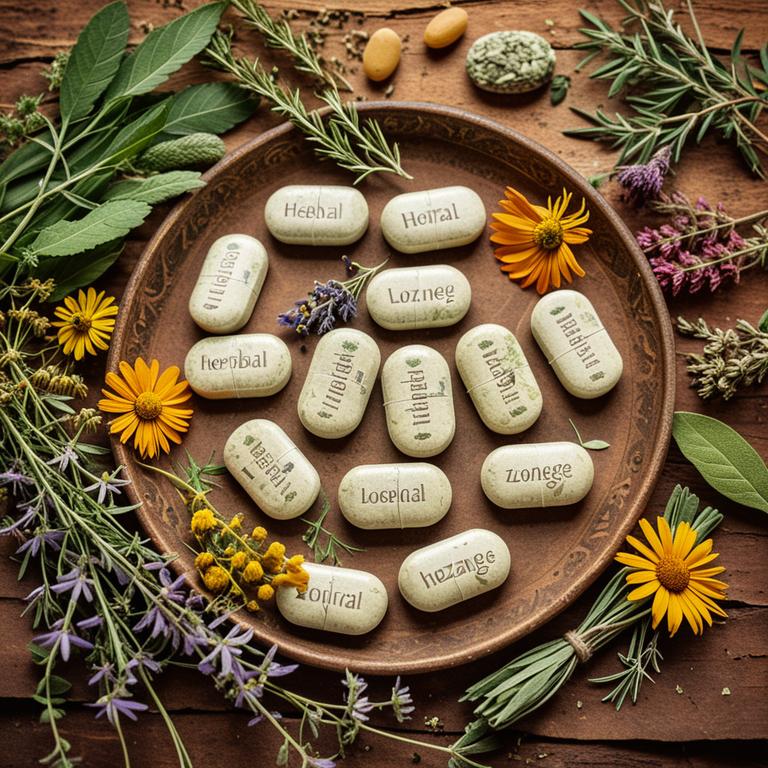
Some of the best medicinal herbal lozenges are formulated with natural ingredients like echinacea, ginger, and licorice root, which are known for their anti-inflammatory and soothing properties.
These lozenges are often used to relieve symptoms of sore throats, coughs, and colds without the use of harsh chemicals. Many herbal lozenges also contain honey or peppermint oil, which can further ease discomfort and promote healing. They are particularly popular among those seeking natural remedies for respiratory issues and mild infections.
Due to their gentle yet effective nature, these lozenges are suitable for both adults and children, making them a versatile choice for seasonal wellness.
FREE Herb Drying Checklist
How to make sure every batch retains maximum flavor, color, and aroma without the risk of mold or over-drying. Eliminate guesswork and trial-and-error, making herb drying faster, easier, and more efficient every time.
Table of Contents
- 1. Zingiber officinale
- 2. Vitex agnus-castus
- 3. Urtica dioica
- 4. Salvia officinalis
- 5. Cinnamomum verum
- 6. Glycyrrhiza glabra
- 7. Echinacea purpurea
- 8. Piper nigrum
- 9. Rosa canina
- 10. Mentha piperita
- 11. Curcuma longa
- 12. Foeniculum vulgare
- 13. Rosmarinus officinalis
- 14. Silybum marianum
- 15. Achillea millefolium
- 16. Cuminum cyminum
- 17. Cinnamomum zeylanicum
- 18. Cnicus benedictus
- 19. Lavandula angustifolia
- 20. Hypericum perforatum
- 21. Thymus vulgaris
- 22. Eucalyptus globulus
- 23. Matricaria chamomilla
- 24. Vitis vinifera
- 25. Sanguinaria canadensis
- 26. Camellia sinensis
- 27. Chamomilla recutita
- 28. Pimpinella anisum
- 29. Sabadilla tinctura
- 30. Aloe barbadensis
- 31. Equisetum arvense
- 32. Sambucus nigra
- 33. Nymphaea alba
- 34. Melissa officinalis
- 35. Nigella sativa
- 36. Sanguisorba officinalis
- 37. Pelargonium graveolens
- 38. Ginkgo biloba
- 39. Echinacea angustifolia
- 40. Artemisia absinthium
- 41. Petroselinum crispum
- 42. Cymbopogon citratus
- 43. Satureja hortensis
- 44. Piper methysticum
- 45. Allium sativum
- 46. Plantago ovata
- 47. Artemisia vulgaris
- 48. Plantago lanceolata
- 49. Prunus domestica
- 50. Hydrastis canadensis
- 51. Sutherlandia frutescens
- 52. Agrimonia eupatoria
- 53. Rhodiola rosea
- 54. Paeonia suffruticosa
- 55. Tribulus terrestris
- 56. Calendula officinalis
- 57. Lepidium meyenii
- 58. Origanum vulgare
- 59. Vitex negundo
- 60. Symphytum officinale
- 61. Ocimum sanctum
- 62. Anethum graveolens
- 63. Nelumbo nucifera
- 64. Rhus toxicaria
- 65. Althaea officinalis
- 66. Panax ginseng
- 67. Crocus sativus
- 68. Santalum album
- 69. Cimicifuga racemosa
- 70. Cyperus rotundus
- 71. Leonurus cardiaca
- 72. Nepeta cataria
- 73. Solanum tuberosum
- 74. Strychnos nux-vomica
- 75. Valeriana officinalis
- 76. Arnica montana
- 77. Paeonia lactiflora
- 78. Boswellia serrata
- 79. Vaccinium myrtillus
- 80. Citrus aurantium
- 81. Tamarindus indica
- 82. Pueraria lobata
- 83. Artemisia annua
- 84. Cymbopogon martinii
- 85. Salvia miltiorrhiza
- 86. Cinnamomum camphora
- 87. Syringa vulgaris
- 88. Papaver rhoeas
- 89. Withania somnifera
- 90. Centella asiatica
- 91. Avena sativa
- 92. Tussilago farfara
- 93. Papaver somniferum
- 94. Hyssopus officinalis
- 95. Eclipta prostrata
- 96. Piper longum
- 97. Thuja occidentalis
- 98. Melaleuca alternifolia
- 99. Cucurbita pepo
- 100. Moringa oleifera
1. Zingiber officinale
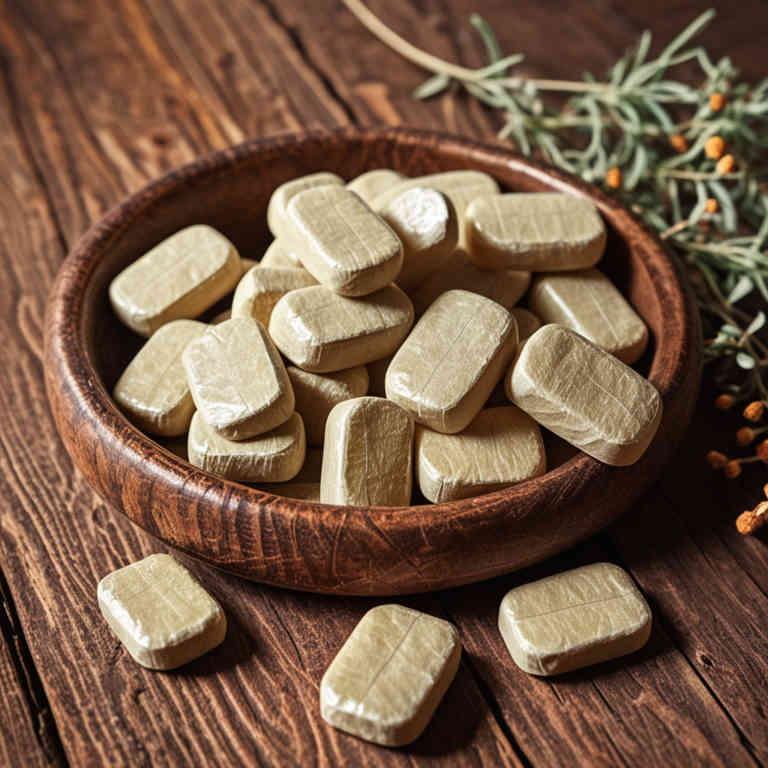
Zingiber officinale herbal lozenges are used to alleviate symptoms of respiratory conditions such as coughs, sore throats, and inflammation.
They contain ginger, which has natural anti-inflammatory and analgesic properties that help reduce irritation and discomfort in the throat. These lozenges are also known to improve circulation and stimulate the immune system, making them beneficial for cold and flu symptoms. The warming effect of ginger can provide a soothing sensation, helping to ease breathing and reduce mucus buildup.
Due to their natural composition, zingiber officinale herbal lozenges are a safe and effective alternative for those seeking non-pharmacological relief from mild respiratory ailments.
2. Vitex agnus-castus

Vitex agnus-castus herbal lozenges are used to support hormonal balance and alleviate symptoms related to menstrual irregularities, such as cramps, mood swings, and premenstrual tension.
These lozenges contain a concentrated form of the chasteberry plant, which has been traditionally used in herbal medicine for its adaptogenic properties. The herbal formulation is designed to be absorbed sublingually, allowing for faster bioavailability and enhanced efficacy. By modulating the pituitary gland's function, vitex agnus-castus may help regulate estrogen and progesterone levels, offering natural relief for women experiencing hormonal imbalances.
This makes them a popular alternative for those seeking holistic approaches to managing reproductive health concerns.
3. Urtica dioica
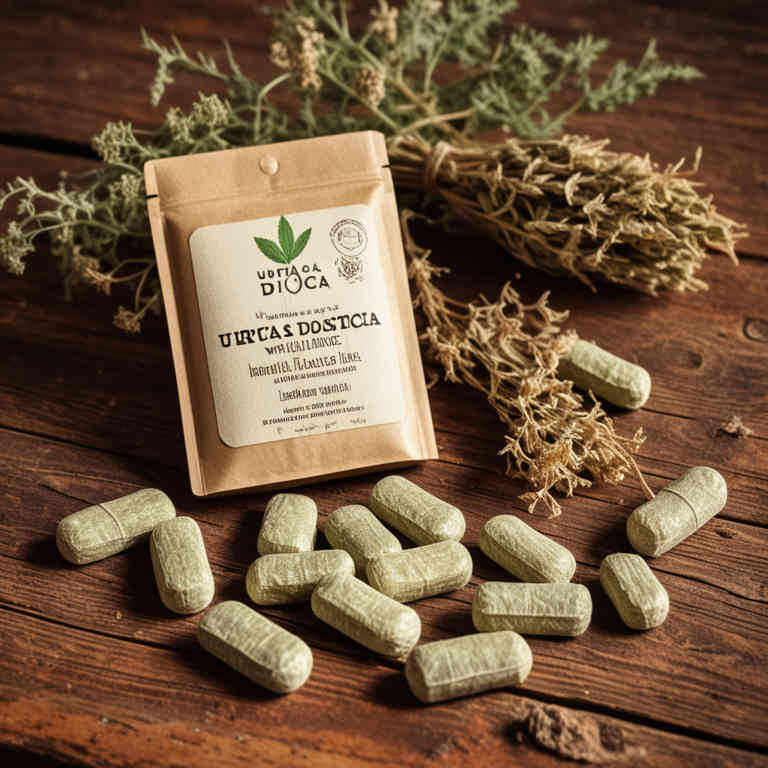
Urtica dioica herbal lozenges are used to soothe sore throats and alleviate symptoms of respiratory tract infections.
These lozenges contain nettle extract, which is known for its anti-inflammatory and antioxidant properties. The natural compounds in urtica dioica help reduce irritation and inflammation in the throat, making them beneficial for people suffering from coughs or colds. They are also preferred by those seeking natural remedies over conventional pharmaceuticals.
Additionally, urtica dioica lozenges may support immune function, contributing to overall respiratory health.
4. Salvia officinalis
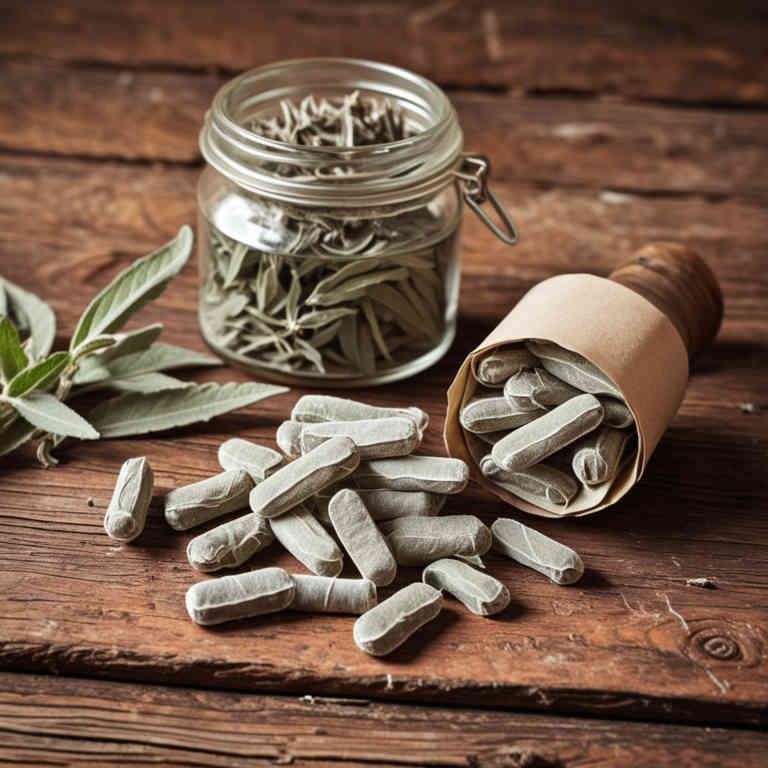
Salvia officinalis herbal lozenges are used to soothe sore throats and relieve symptoms of respiratory infections due to their anti-inflammatory and antimicrobial properties.
These lozenges contain sage, which has been traditionally used to reduce mucus production and ease coughing. The natural compounds in salvia officinalis, such as thujone and flavonoids, help to reduce irritation and promote healing in the throat. They are also beneficial for individuals suffering from chronic cough or postnasal drip, as they can help to clear congestion and reduce throat discomfort.
Overall, salvia officinalis herbal lozenges offer a natural and effective alternative for managing common throat and respiratory issues.
5. Cinnamomum verum

Cinnamomum verum herbal lozenges are used to soothe sore throats and reduce inflammation in the respiratory tract due to their antimicrobial and anti-inflammatory properties.
The active compounds in cinnamon, such as cinnamaldehyde and eugenol, help combat bacteria and viruses that may cause throat infections. These lozenges also provide a warming effect that can relieve discomfort and promote healing of minor throat irritations. Additionally, they are often used to freshen breath and alleviate symptoms of colds and coughs.
Their natural formulation makes them a safe and effective alternative for those seeking herbal remedies for mild respiratory issues.
6. Glycyrrhiza glabra
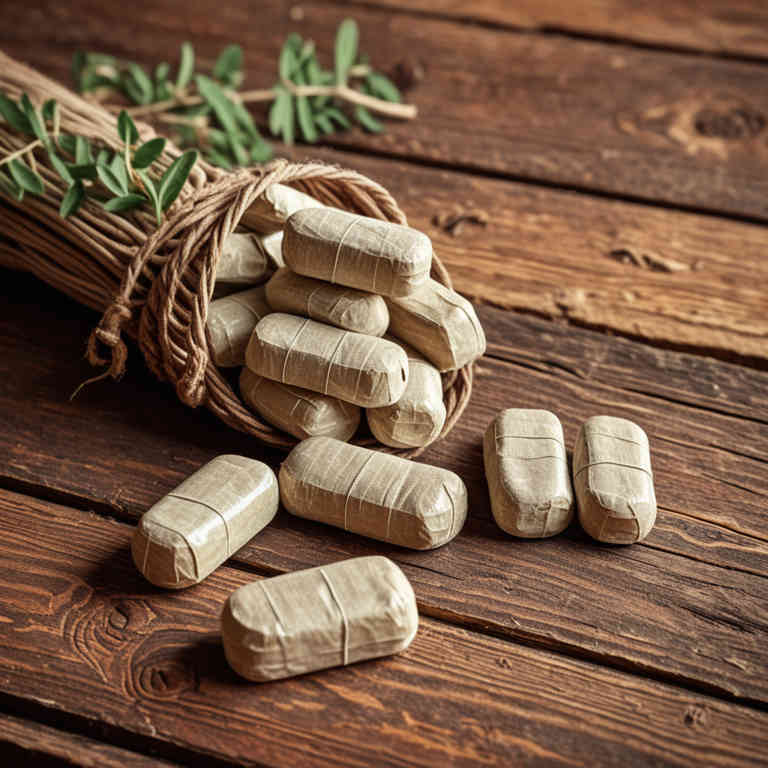
Glycyrrhiza glabra herbal lozenges are used to soothe sore throats and reduce inflammation in the respiratory tract due to their anti-inflammatory and antimicrobial properties.
These lozenges contain glycyrrhizin, a compound known for its ability to inhibit viral replication, making them effective in alleviating symptoms of colds and coughs. They also help to moisten the mucous membranes, providing relief from dryness and irritation. The natural sweetness of licorice root makes the lozenges palatable and easier to consume regularly.
Overall, glycyrrhiza glabra herbal lozenges are a popular choice for natural remedies in supporting respiratory health and comfort.
7. Echinacea purpurea
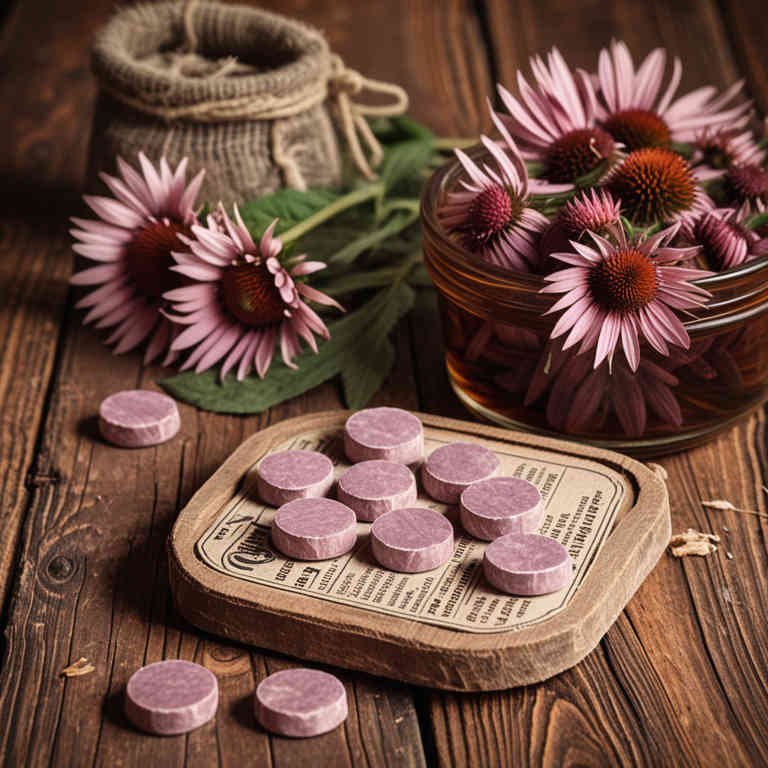
Echinacea purpurea herbal lozenges are used to support the immune system and alleviate symptoms of the common cold.
These lozenges contain echinacea, a herb known for its potential anti-inflammatory and antiviral properties. They are often recommended for people experiencing mild respiratory infections due to their soothing effect on the throat. The lozenges can help reduce the duration and severity of cold symptoms by promoting healing and reducing irritation.
Their natural formulation makes them a popular choice for those seeking alternative or complementary remedies for respiratory discomfort.
8. Piper nigrum
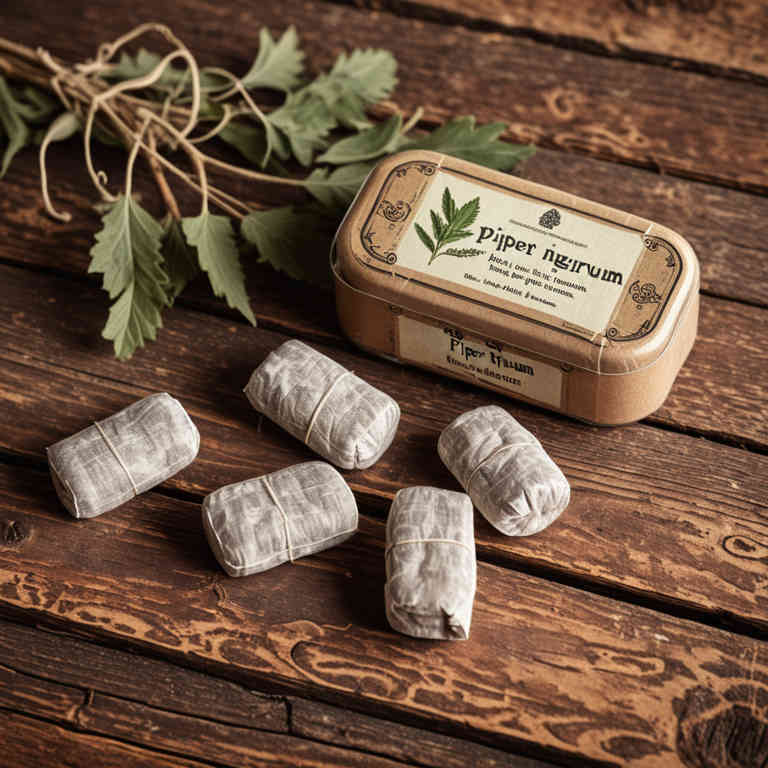
Piper nigrum herbal lozenges are used to soothe sore throats and alleviate symptoms of respiratory infections due to their natural antiseptic and anti-inflammatory properties.
These lozenges contain black pepper, which is known for its ability to reduce mucus production and ease coughing. The warming effect of piper nigrum helps to stimulate blood circulation in the throat, promoting faster healing of minor irritations. Additionally, the herbal formulation provides a pleasant taste and can be a safe alternative for those seeking natural remedies.
They are particularly beneficial for individuals looking to avoid synthetic medications while managing mild to moderate throat discomfort.
9. Rosa canina

Rosa canina herbal lozenges are used to support respiratory health by soothing sore throats and reducing inflammation in the throat and bronchial passages.
They contain high levels of vitamin C, which helps boost the immune system and may shorten the duration of colds and flu. These lozenges also provide antioxidant benefits that protect the body from oxidative stress and support overall immune function. Their natural formulation makes them a gentle option for people seeking alternatives to conventional cough medicines.
Due to their combination of therapeutic properties and mild side effects, rosa canina herbal lozenges are a popular choice for those looking to manage mild respiratory symptoms naturally.
10. Mentha piperita
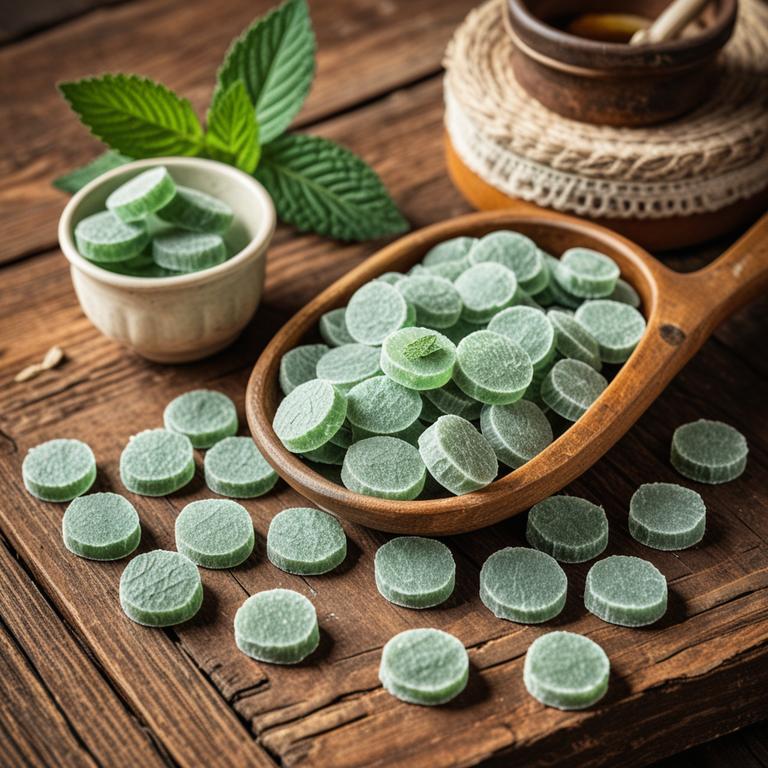
Mentha piperita herbal lozenges are used to relieve symptoms of sore throat and cough by their cooling and soothing properties.
The active ingredient, menthol, helps to numb the mouth and throat, reducing irritation and pain. These lozenges are also effective in alleviating nasal congestion by promoting clear breathing through their decongestant effects. They are often recommended for individuals suffering from colds or respiratory infections due to their natural antiseptic qualities.
Because they are generally safe and free from harsh chemicals, mentha piperita lozenges are a preferred choice for both adults and children seeking natural relief.
11. Curcuma longa
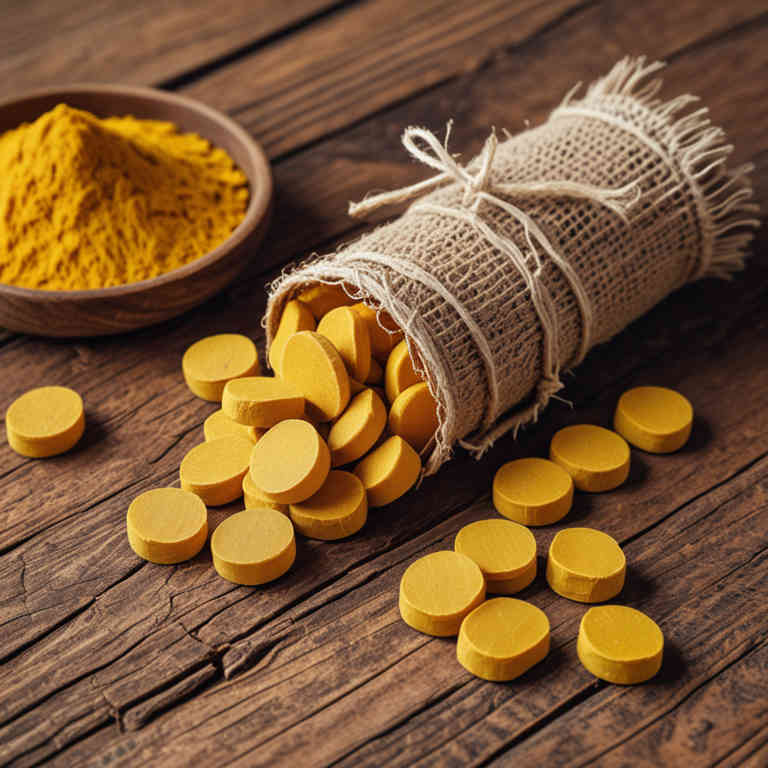
Curcuma longa herbal lozenges are used to alleviate symptoms of sore throat and inflammation in the throat due to their anti-inflammatory and antimicrobial properties.
These lozenges contain curcumin, a compound known for its potent antioxidant effects, which help reduce oxidative stress and promote healing. They are particularly beneficial for individuals suffering from conditions like pharyngitis or laryngitis, as they can soothe irritation and ease discomfort. The natural formulation makes them a preferred choice for those seeking alternative or complementary treatments.
Overall, curcuma longa herbal lozenges offer a safe and effective way to support throat health and recovery.
12. Foeniculum vulgare
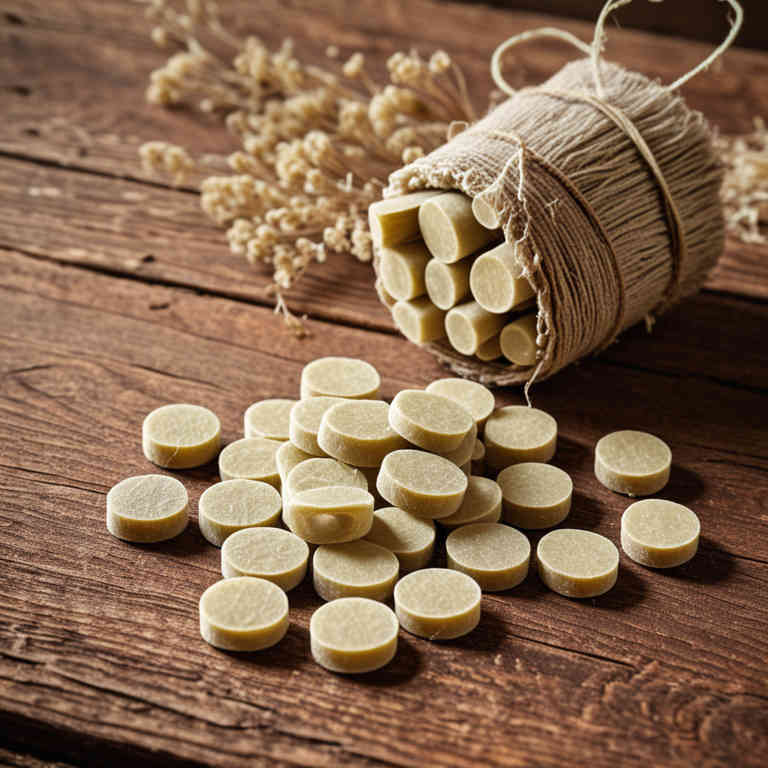
Foeniculum vulgare herbal lozenges are used to relieve symptoms of respiratory and digestive discomfort.
These lozenges contain the active ingredient fennel, which has natural antispasmodic and anti-inflammatory properties. They are commonly used to soothe sore throats, reduce coughing, and ease digestive issues like bloating and gas. The aromatic compounds in fennel also help to freshen breath and provide a calming effect.
Due to their mild and generally safe nature, these lozenges are often recommended for children and adults alike as a natural remedy for mild ailments.
13. Rosmarinus officinalis
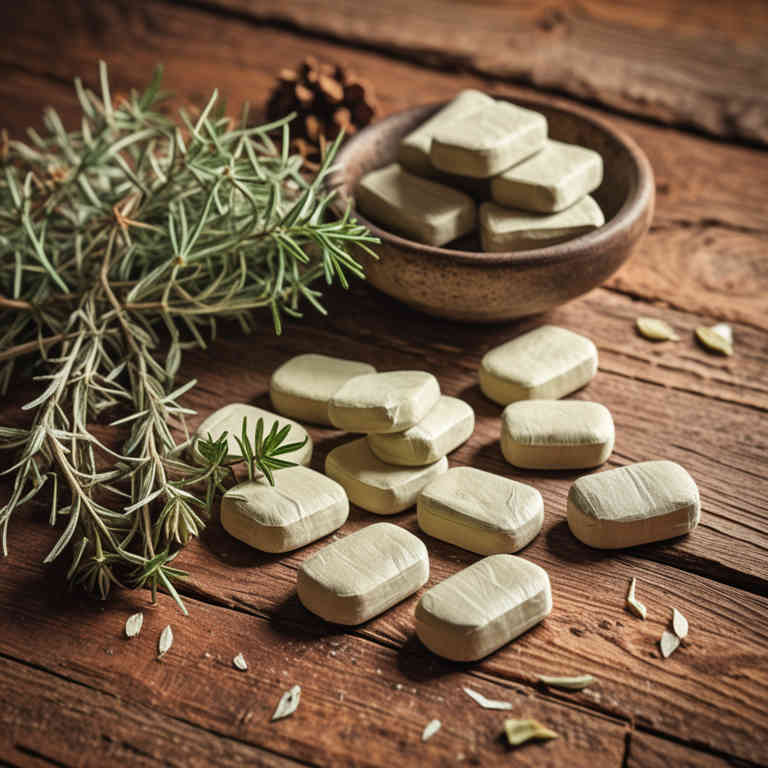
Rosmarinus officinalis herbal lozenges are used to soothe sore throats and alleviate symptoms of respiratory infections due to their antimicrobial and anti-inflammatory properties.
These lozenges contain rosemary extract, which has been traditionally valued for its ability to reduce inflammation and fight off harmful bacteria and viruses. The aromatic compounds in rosemary also help to refresh breath and provide a calming effect, making them beneficial for individuals suffering from chronic coughs or frequent throat irritation. Additionally, the natural antioxidants in rosmarinus officinalis support immune health, enhancing the body's ability to combat illness.
Overall, these lozenges offer a natural and effective alternative for managing throat discomfort and supporting respiratory wellness.
14. Silybum marianum
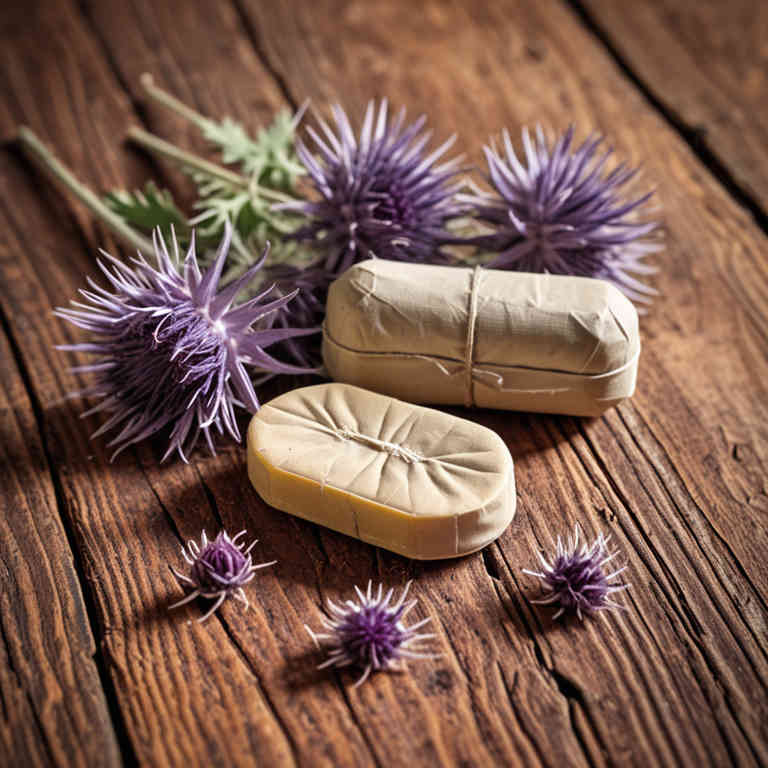
Silybum marianum herbal lozenges are used to support digestive health and alleviate symptoms of gastrointestinal discomfort.
These lozenges contain silymarin, a compound known for its antioxidant and anti-inflammatory properties, which can help protect the liver and promote the healing of the digestive tract. They are particularly beneficial for individuals experiencing indigestion, bloating, or mild inflammation of the stomach lining. The slow dissolution of the lozenges allows for prolonged contact with the oral and esophageal tissues, enhancing their therapeutic effect.
Overall, silybum marianum herbal lozenges offer a natural and targeted approach to managing digestive issues with minimal side effects.
15. Achillea millefolium
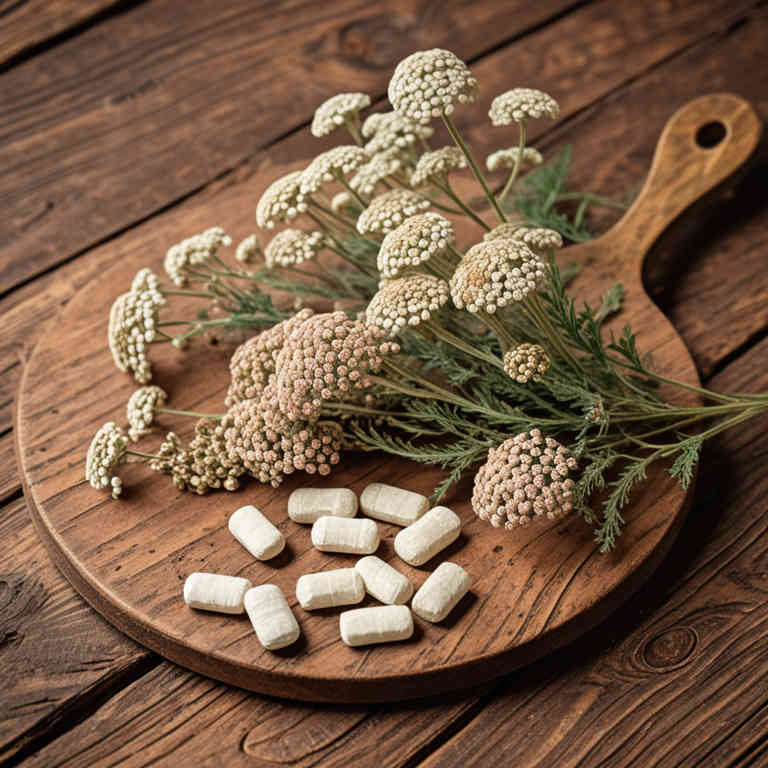
Achillea millefolium herbal lozenges are used to soothe sore throats and alleviate symptoms of respiratory infections due to their anti-inflammatory and antiseptic properties.
These lozenges contain a blend of the plant's essential oils, which have been traditionally valued for their ability to reduce irritation and promote healing in the throat. The herb is also believed to support immune function, making it a popular choice for those seeking natural remedies during cold and flu season. Additionally, the menthol-like compounds in achillea millefolium can provide a cooling effect, which helps ease discomfort and encourage easier breathing.
Overall, these lozenges offer a gentle, natural approach to managing common throat and respiratory issues.
16. Cuminum cyminum

Cuminum cyminum herbal lozenges are used to soothe sore throats and reduce inflammation in the respiratory tract.
These lozenges contain cumin seeds, which have natural antimicrobial and anti-inflammatory properties that help fight off infections. They are particularly beneficial for individuals suffering from colds, coughs, or other throat irritations. The warming effect of cumin also helps to relieve congestion and improve breathing.
Due to their natural ingredients and therapeutic benefits, cuminum cyminum herbal lozenges are a popular choice for those seeking alternative or complementary remedies for minor respiratory discomfort.
17. Cinnamomum zeylanicum

Cinnamomum zeylanicum herbal lozenges are used to soothe sore throats and alleviate symptoms of respiratory infections due to their antimicrobial and anti-inflammatory properties.
These lozenges contain cinnamon, which has been traditionally used for its warming and comforting effects on the throat. The aromatic compounds in cinnamon help reduce irritation and provide a pleasant taste, making them a popular choice for those suffering from colds or coughs. Additionally, they may help stimulate saliva production, which can further ease discomfort and promote healing.
Their natural composition makes them a safe and effective alternative for individuals seeking herbal remedies for mild throat and respiratory ailments.
18. Cnicus benedictus

Cnicus benedictus herbal lozenges are used to soothe sore throats and reduce inflammation in the respiratory tract.
These lozenges contain the plant known as blessed thistle, which has been traditionally valued for its antimicrobial and anti-inflammatory properties. The active compounds in Cnicus benedictus help to alleviate discomfort caused by coughing, irritation, and minor infections. They are particularly beneficial for individuals suffering from colds, flu, or chronic throat conditions.
Due to their natural composition, these lozenges offer a gentler alternative to conventional throat medications, making them a preferred choice for those seeking holistic remedies.
19. Lavandula angustifolia
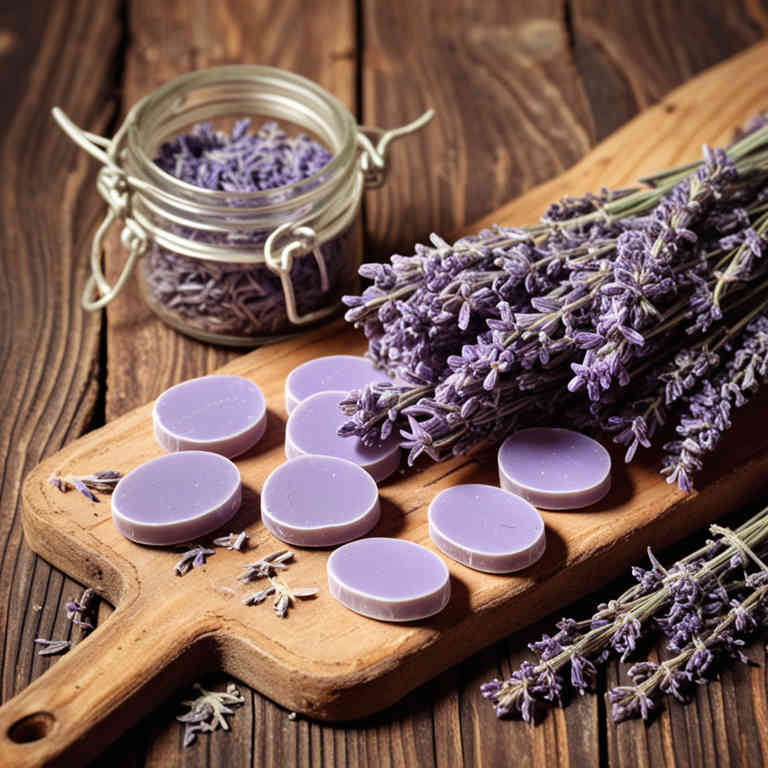
Lavandula angustifolia herbal lozenges are used to soothe sore throats and alleviate symptoms of respiratory infections due to their calming and anti-inflammatory properties.
The essential oils in lavender, such as linalool and lavandic acid, have been shown to reduce inflammation and ease discomfort in the throat. These lozenges also help to promote relaxation and reduce stress, which can indirectly support immune function. Their pleasant aroma makes them a comforting remedy for those suffering from colds or coughs.
Overall, lavender lozenges offer a natural and effective way to manage common throat and respiratory ailments.
20. Hypericum perforatum
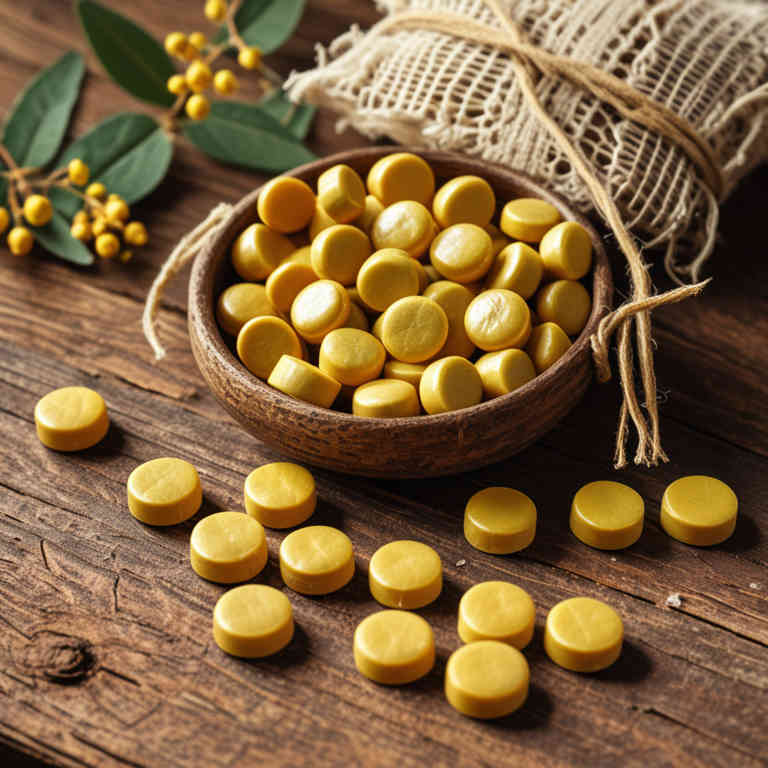
Hypericum perforatum herbal lozenges are used to alleviate symptoms of mild to moderate depression and improve mood by supporting emotional well-being.
These lozenges contain hypericin and other bioactive compounds that may help regulate neurotransmitters such as serotonin and dopamine, which are associated with mood regulation. They are often recommended as a natural alternative or complement to conventional antidepressants, particularly for individuals seeking non-pharmacological options. The lozenge form allows for easy administration and can be soothing for the throat, making it suitable for use during colds or sore throats.
Overall, hypericum perforatum herbal lozenges are valued for their potential to enhance mental health and provide comfort through a holistic approach.
21. Thymus vulgaris
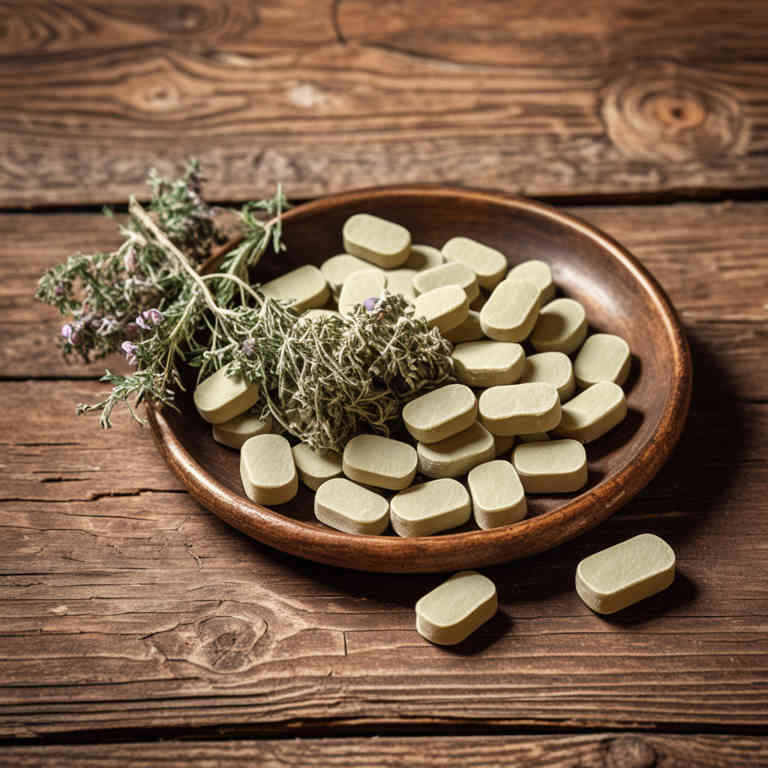
Thymus vulgaris herbal lozenges are used to support respiratory health by alleviating symptoms of sore throat and cough.
These lozenges contain thyme, a herb known for its antimicrobial and anti-inflammatory properties, which help reduce throat irritation and fight off infections. They are also effective in soothing the mucous membranes of the respiratory tract, making them a natural remedy for colds and flu. The essential oils in thyme, such as thymol, contribute to their ability to combat bacteria and viruses that cause respiratory ailments.
Overall, thymus vulgaris herbal lozenges are a safe and effective option for those seeking natural relief from common throat and respiratory issues.
22. Eucalyptus globulus
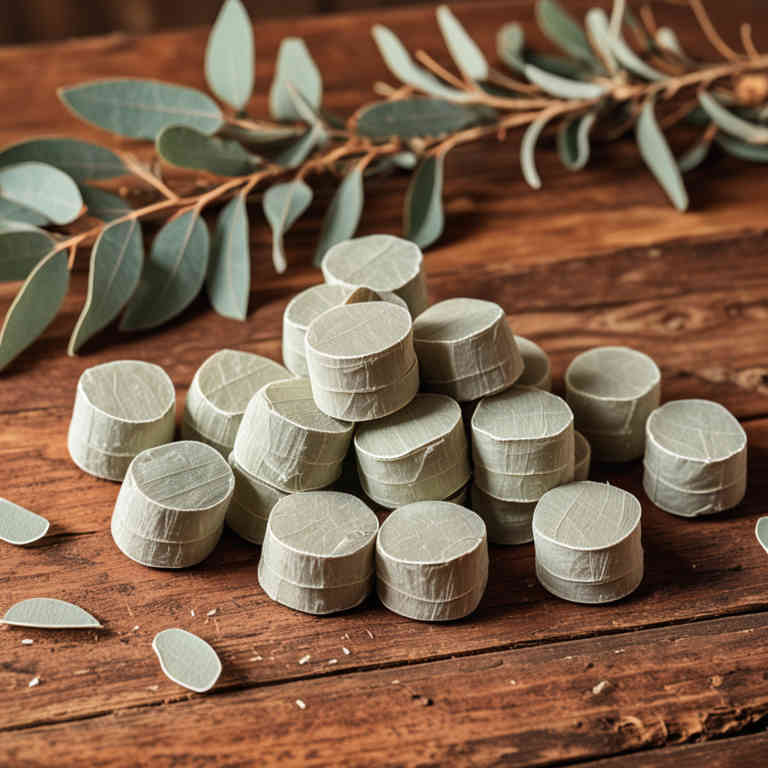
Eucalyptus globulus herbal lozenges are used to relieve symptoms of respiratory tract infections such as coughs, sore throats, and nasal congestion.
They contain eucalyptus oil, which has natural decongestant and anti-inflammatory properties that help ease breathing and reduce irritation in the throat. These lozenges work by providing a soothing effect when dissolved in the mouth, offering temporary relief from discomfort. Their menthol-like aroma also helps to clear the airways and promote a sense of freshness.
Due to their natural composition and effectiveness, they are a popular choice for those seeking alternative or complementary remedies for mild respiratory issues.
23. Matricaria chamomilla

Matricaria chamomilla herbal lozenges are used to soothe sore throats and relieve symptoms of mild respiratory discomfort.
These lozenges contain chamomile, a herb known for its calming and anti-inflammatory properties. The active compounds in chamomile, such as bisabolol and flavonoids, help reduce irritation and inflammation in the throat. They are particularly beneficial for individuals experiencing coughing, hoarseness, or a scratchy sensation in the throat.
Due to their natural composition, these lozenges are a gentle and effective alternative for those seeking non-pharmaceutical relief from throat discomfort.
24. Vitis vinifera
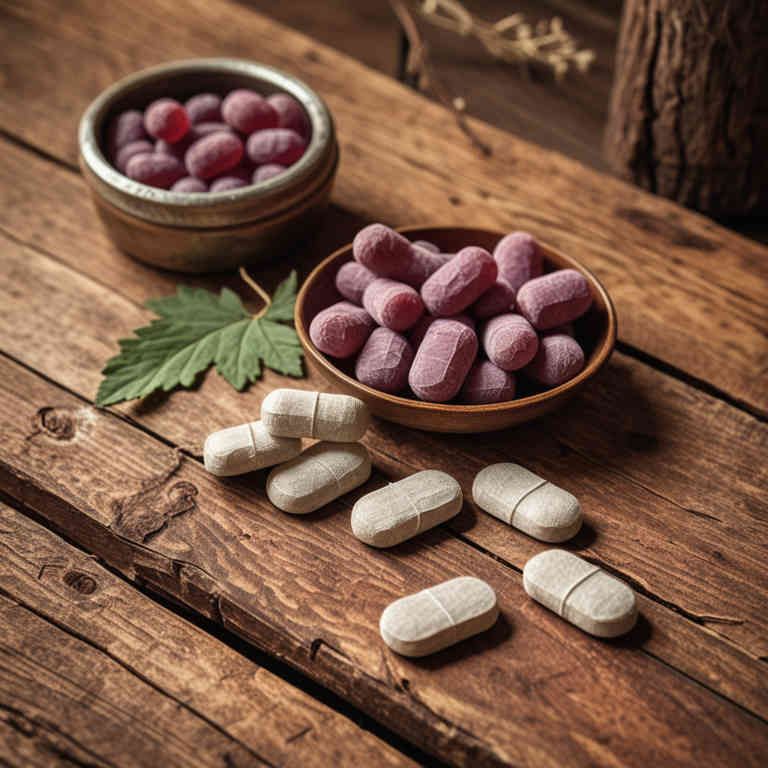
Vitis vinifera herbal lozenges are used to soothe sore throats and alleviate symptoms of mild respiratory infections due to their anti-inflammatory and antimicrobial properties.
These lozenges contain extracts from the grapevine, which are rich in polyphenols and resveratrol, known for their ability to reduce inflammation and combat harmful bacteria. They are particularly beneficial for individuals experiencing dryness or irritation in the throat, offering a natural and gentle remedy. The slow release of active compounds provides prolonged relief, making them suitable for use throughout the day.
Additionally, they are a preferred choice for those seeking alternative or complementary therapies to conventional treatments.
25. Sanguinaria canadensis
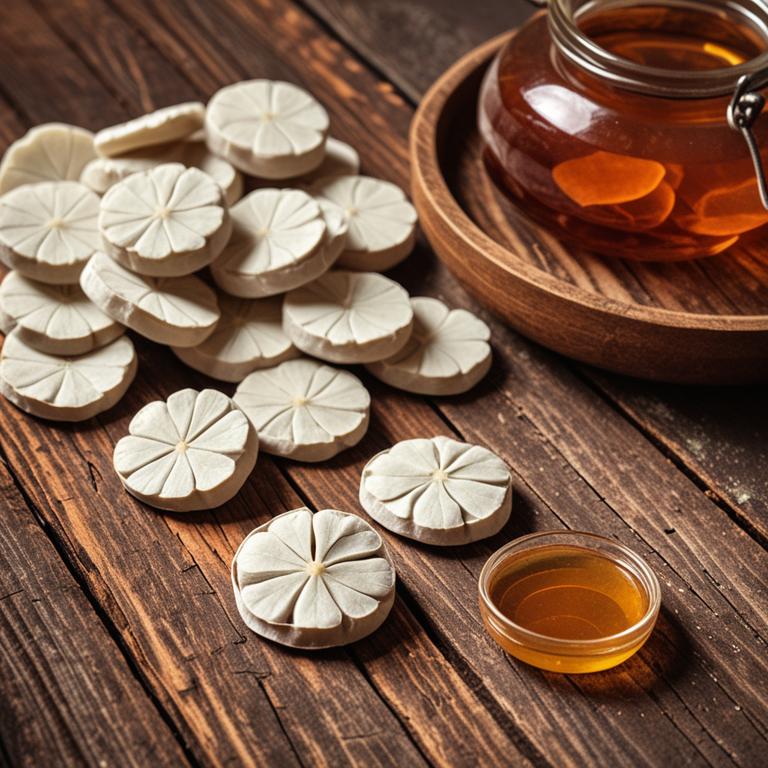
Sanguinaria canadensis herbal lozenges are used to alleviate symptoms of sore throat and respiratory infections due to their antimicrobial and anti-inflammatory properties.
These lozenges contain the root of the bloodroot plant, which has been traditionally used in Native American medicine for its healing properties. The active compounds in sanguinaria canadensis, such as sanguinarine, help reduce pain and inflammation in the throat, making them effective for temporary relief. They are also believed to support the body's natural defense mechanisms against viral and bacterial infections.
However, due to potential toxicity, they should be used with caution and under the guidance of a healthcare professional.
26. Camellia sinensis
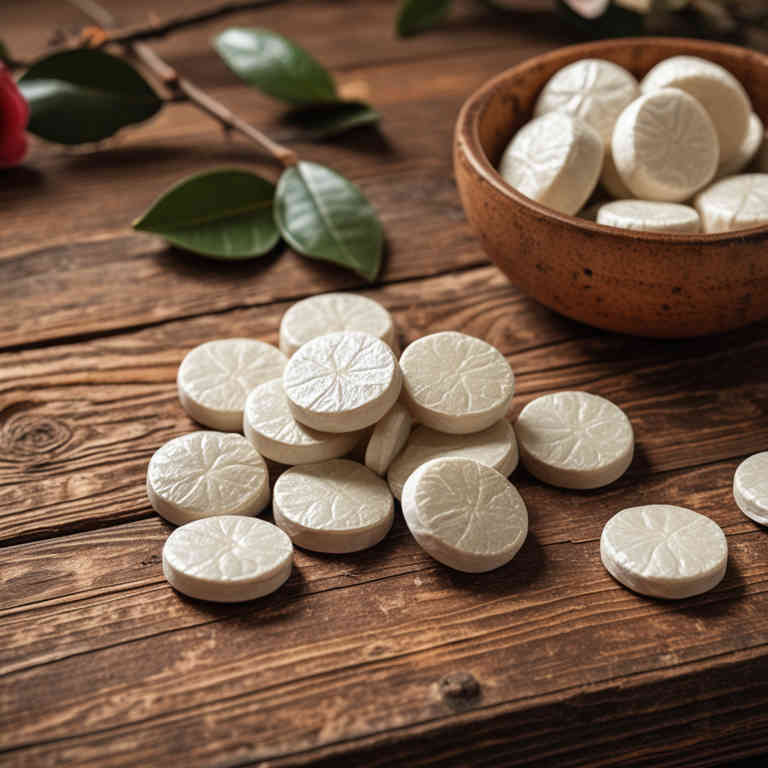
Camellia sinensis herbal lozenges are used to soothe sore throats and reduce inflammation in the mouth.
These lozenges contain active compounds from green tea, such as catechins, which have antimicrobial and anti-inflammatory properties. They are also beneficial for individuals suffering from colds or respiratory infections due to their ability to ease symptoms. The natural ingredients in these lozenges provide a gentle and safe alternative to over-the-counter medications.
Overall, camellia sinensis herbal lozenges offer a natural way to support oral health and alleviate discomfort associated with various throat conditions.
27. Chamomilla recutita

Chamomilla recutita herbal lozenges are used to soothe sore throats and reduce inflammation in the mouth and throat.
They contain chamomile, which has natural anti-inflammatory and antimicrobial properties that help combat infections and irritation. These lozenges are particularly beneficial for individuals suffering from colds, sore throats, or minor mouth ulcers. The calming effect of chamomile also helps alleviate stress and promote relaxation, making them a gentle remedy for both physical and emotional discomfort.
Their mild flavor and ease of use make them a popular choice for people of all ages seeking natural relief.
28. Pimpinella anisum
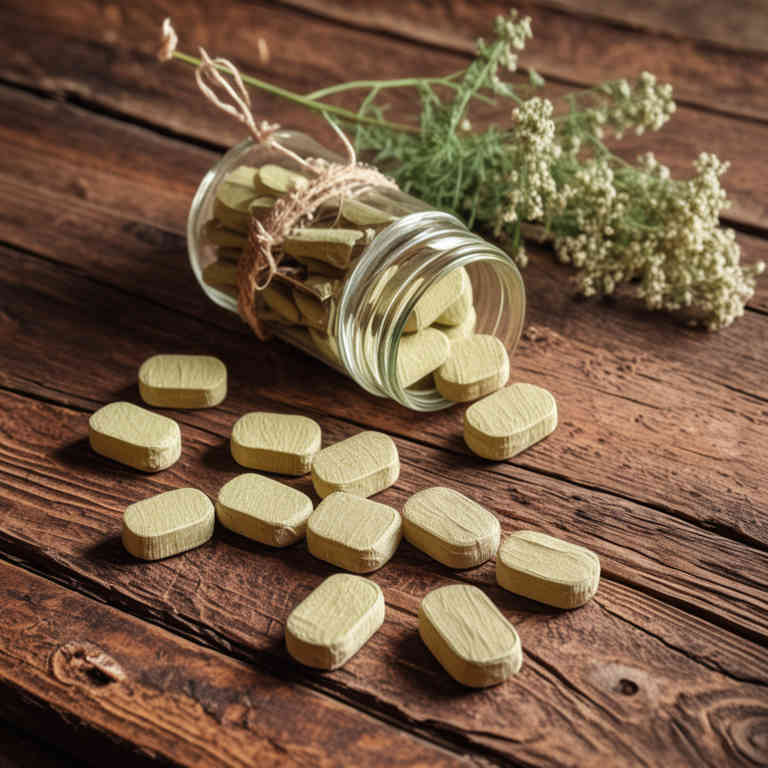
Pimpinella anisum herbal lozenges are used to relieve symptoms of sore throat and cough due to their expectorant and antispasmodic properties.
These lozenges contain anise oil, which has a soothing effect on the throat and helps to loosen mucus, making it easier to expel. They are also known to have a mild analgesic effect, which can reduce pain and irritation in the throat. The natural ingredients in these lozenges make them a safe alternative for those seeking herbal remedies for respiratory discomfort.
Their pleasant licorice-like flavor encourages regular use, enhancing their effectiveness in providing relief.
29. Sabadilla tinctura
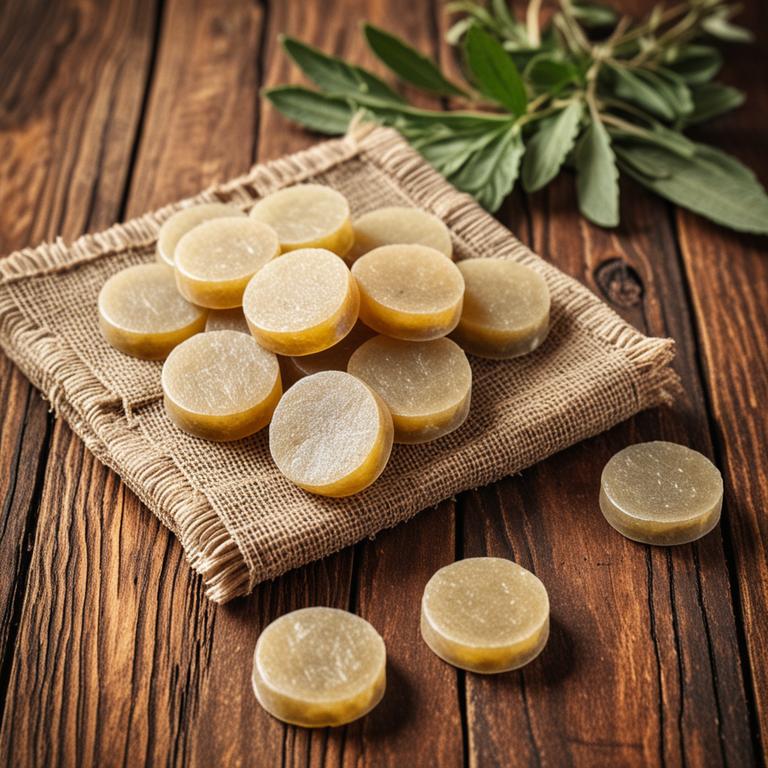
Sabadilla tinctura herbal lozenges are used to alleviate symptoms of respiratory conditions such as coughs, sore throats, and inflammation of the mucous membranes.
These lozenges contain sabadilla, a plant-based ingredient known for its expectorant and antispasmodic properties, which help loosen mucus and reduce throat irritation. They are particularly beneficial for individuals suffering from chronic coughs or bronchitis, as they can soothe the throat and ease breathing. The herbal formulation is often preferred by those seeking natural remedies with minimal side effects.
Overall, sabadilla tinctura herbal lozenges offer a gentle yet effective way to support respiratory health and comfort.
30. Aloe barbadensis
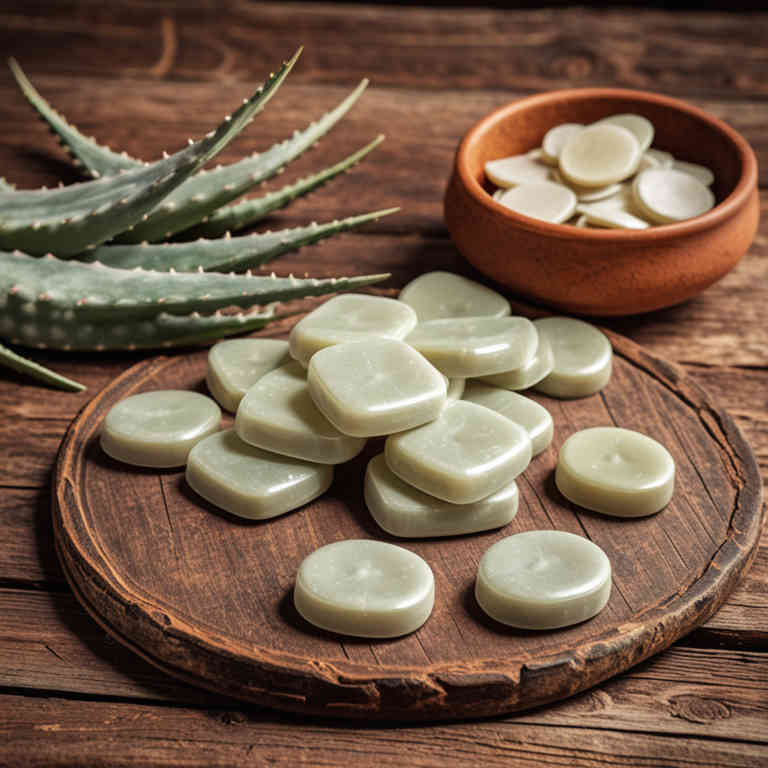
Aloe barbadensis herbal lozenges are used to soothe sore throats and reduce irritation caused by colds, soreness, or inflammation.
They contain natural aloe vera gel, which has anti-inflammatory and antimicrobial properties that help in healing the throat lining. These lozenges are particularly beneficial for individuals suffering from chronic throat conditions or frequent respiratory infections. The cooling effect of aloe provides immediate relief, making them a preferred choice for natural remedies.
Additionally, they are often preferred over traditional lozenges because they are free from harsh chemicals and offer a gentler, more holistic approach to throat care.
31. Equisetum arvense
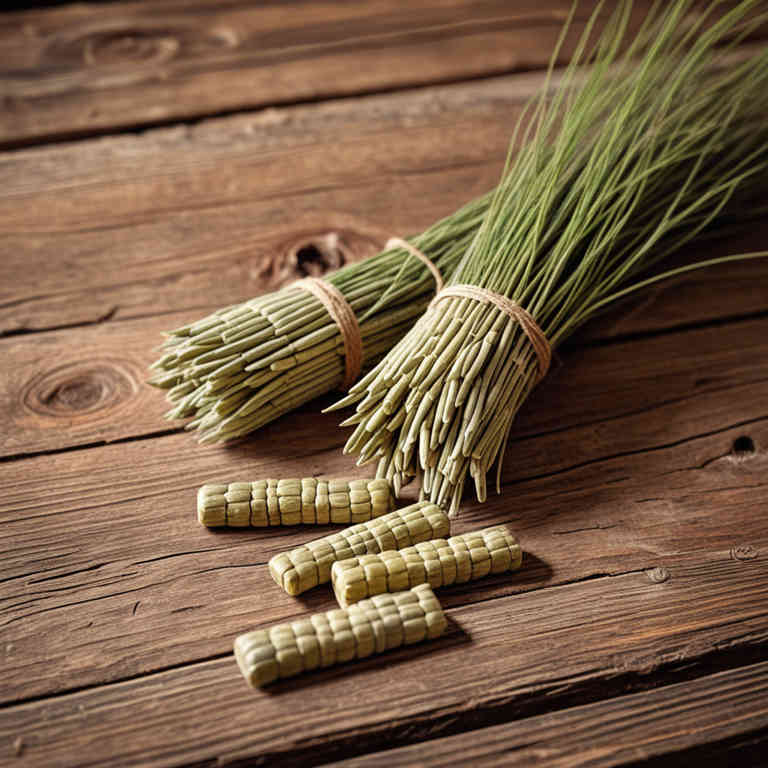
Equisetum arvense herbal lozenges are used to alleviate symptoms of respiratory conditions such as coughs, sore throats, and bronchitis by their soothing and anti-inflammatory properties.
These lozenges contain extracts from the horsetail plant, which is rich in minerals and antioxidants that help reduce irritation and promote healing in the throat. The natural compounds in equisetum arvense may also support immune function, making them a beneficial supplement during cold and flu seasons. They are particularly favored for their gentle formulation, which is suitable for long-term use without causing significant side effects.
Overall, equisetum arvense herbal lozenges offer a natural and effective alternative for managing common throat and respiratory discomforts.
32. Sambucus nigra
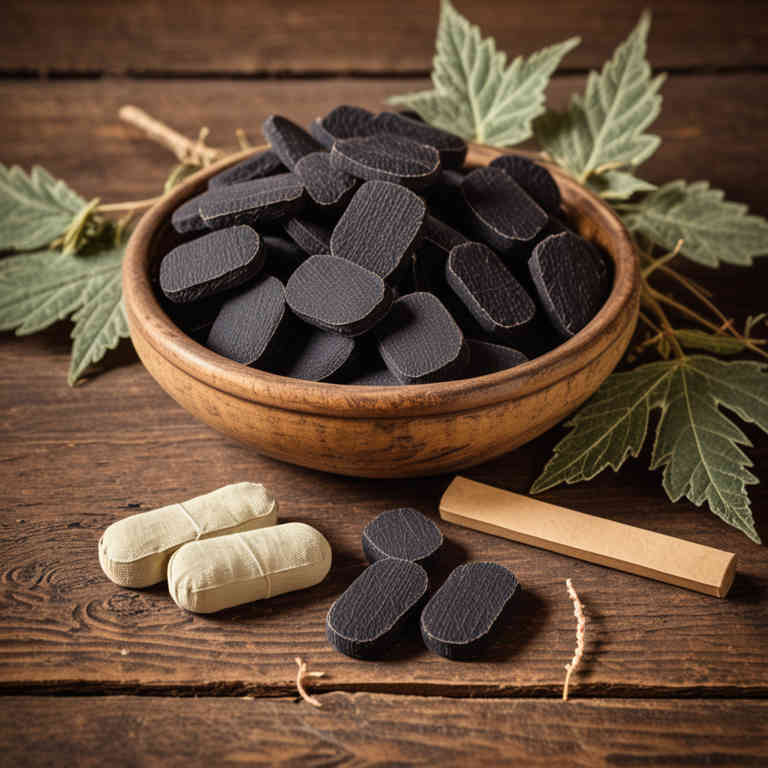
Sambucus nigra herbal lozenges are used to soothe sore throats and alleviate symptoms of colds and coughs due to their antiviral and anti-inflammatory properties.
These lozenges contain compounds like flavonoids and mucilage, which help reduce irritation and inflammation in the throat. They are also believed to support immune function, making them a popular choice during the flu season. The natural ingredients in sambucus nigra provide a gentler alternative to over-the-counter medications for those seeking herbal remedies.
Overall, these lozenges offer a traditional and effective way to manage mild respiratory discomfort.
33. Nymphaea alba
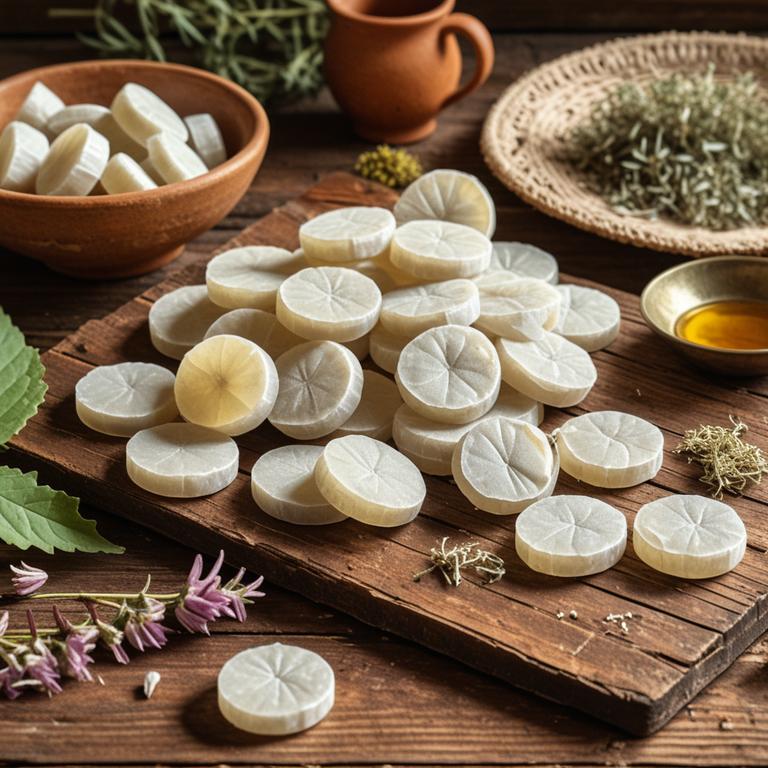
Nymphaea alba herbal lozenges are used to soothe sore throats and alleviate symptoms of respiratory tract infections.
These lozenges contain extracts from the white water lily, which is known for its anti-inflammatory and antimicrobial properties. The natural compounds in nymphaea alba help reduce irritation and inflammation in the throat, providing relief from coughing and discomfort. They are particularly beneficial for individuals seeking natural remedies without the side effects of conventional medications.
Due to their calming and healing properties, these lozenges are a popular choice for those looking to support throat health and ease mild respiratory issues.
34. Melissa officinalis
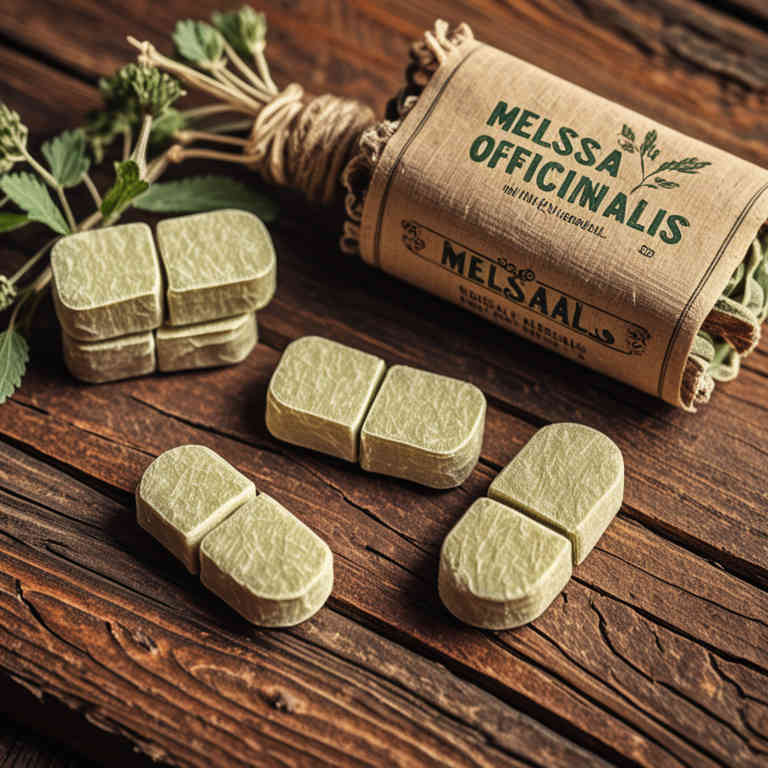
Melissa officinalis herbal lozenges are used to soothe sore throats and alleviate symptoms of respiratory infections due to their anti-inflammatory and antimicrobial properties.
These lozenges contain essential oils and flavonoids that help reduce irritation and inflammation in the throat, making them effective for minor throat discomfort. They are also known to support immune function, which can help the body fight off viral infections more efficiently. The pleasant aroma of lemon balm in the lozenges can have a calming effect, reducing stress and promoting relaxation.
Overall, melissa officinalis herbal lozenges offer a natural and gentle remedy for those seeking relief from common throat and respiratory ailments.
35. Nigella sativa

Nigella sativa herbal lozenges are used to alleviate symptoms of respiratory conditions such as coughs, sore throats, and nasal congestion due to their anti-inflammatory and antimicrobial properties.
These lozenges contain thymoquinone, a bioactive compound known for its ability to reduce inflammation and fight infections in the respiratory tract. They are particularly beneficial for individuals suffering from chronic bronchitis or allergies, as they help soothe irritation and improve breathing. The natural formulation of these lozenges makes them a safe alternative for those seeking non-pharmaceutical remedies.
Additionally, their pleasant taste and easy dissolving form make them convenient for regular use throughout the day.
36. Sanguisorba officinalis
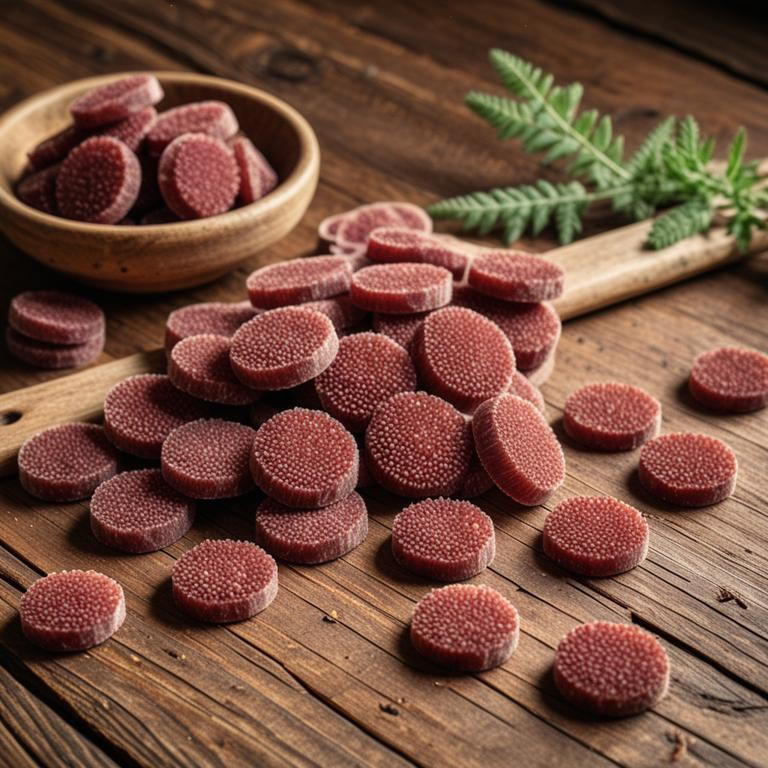
Sanguisorba officinalis herbal lozenges are used to soothe sore throats and alleviate symptoms of respiratory infections due to their anti-inflammatory and antimicrobial properties.
These lozenges help reduce irritation and inflammation in the throat, making them beneficial for individuals suffering from colds, flu, or other throat-related discomforts. The herb is known for its ability to support the body's natural defenses, promoting faster recovery from minor ailments. They are also preferred for their natural composition, offering a safer alternative to conventional lozenges containing synthetic additives.
Overall, sanguisorba officinalis herbal lozenges are a valuable remedy for maintaining throat health and supporting immune function.
37. Pelargonium graveolens

Pelargonium graveolens herbal lozenges are used to alleviate symptoms of respiratory infections and sore throats due to their antimicrobial and anti-inflammatory properties.
These lozenges contain essential oils derived from the plant, which have been traditionally used for their soothing effects on irritated mucous membranes. The natural compounds in pelargonium graveolens, such as geraniol and limonene, help reduce inflammation and fight off harmful bacteria and viruses. They are particularly beneficial for individuals seeking natural remedies without harsh pharmaceutical ingredients.
Overall, these lozenges offer a safe and effective alternative for managing minor respiratory discomfort and promoting throat health.
38. Ginkgo biloba

Ginkgo biloba herbal lozenges are used to support respiratory health by promoting clear airways and reducing congestion.
These lozenges contain extracts from the ginkgo biloba tree, which is known for its antioxidant and anti-inflammatory properties. The active compounds in ginkgo biloba may help alleviate symptoms of coughing and throat irritation by soothing the mucous membranes. They are also believed to enhance immune function, making them a popular choice for those seeking natural remedies for colds or seasonal allergies.
Due to their mild and soothing effects, ginkgo biloba lozenges are often recommended for individuals looking for a gentle alternative to conventional throat medications.
39. Echinacea angustifolia
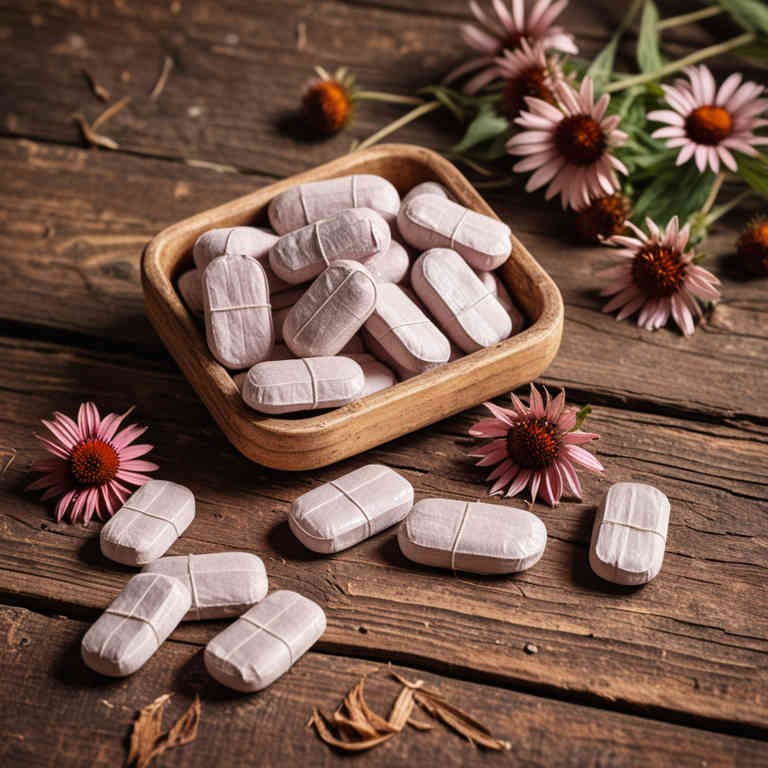
Echinacea angustifolia herbal lozenges are used to support the immune system and alleviate symptoms of colds and respiratory infections.
These lozenges contain echinacea, a plant known for its potential anti-inflammatory and immunostimulant properties. They are often recommended for people seeking natural remedies to reduce the duration and severity of upper respiratory tract infections. The lozenges provide a convenient way to consume echinacea, allowing for consistent dosing and easy integration into daily routines.
Their use is particularly beneficial for individuals looking to enhance their body's defenses without relying on synthetic medications.
40. Artemisia absinthium
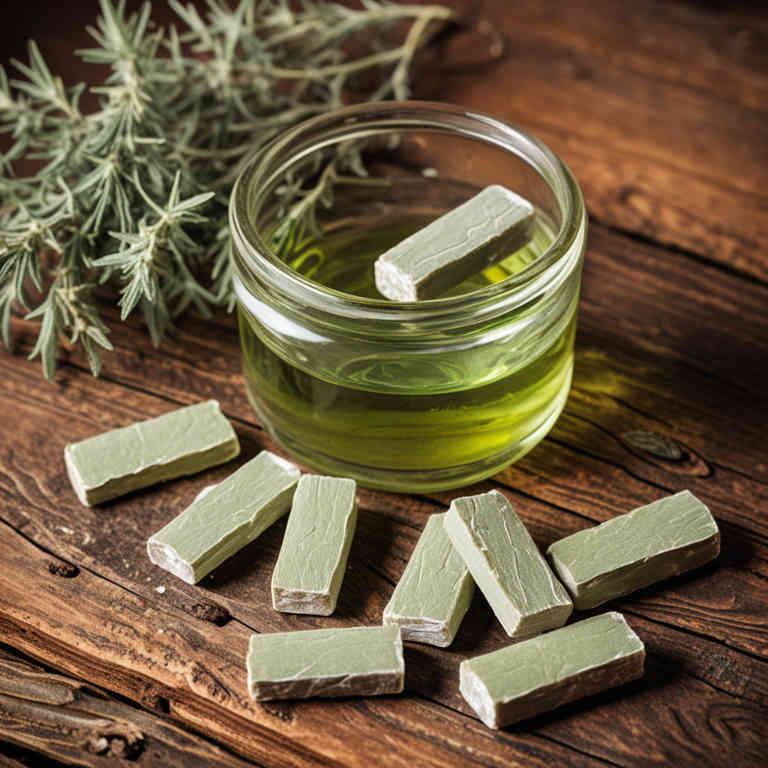
Artemisia absinthium herbal lozenges are used to support respiratory health by soothing sore throats and reducing inflammation in the airways.
These lozenges contain compounds known for their antimicrobial and anti-inflammatory properties, which can help alleviate symptoms of colds, coughs, and other respiratory infections. They are also believed to aid in clearing mucus and improving overall breathing, making them a popular choice for those suffering from persistent throat irritation. The natural ingredients in these lozenges provide a gentler alternative to over-the-counter medications, offering a holistic approach to wellness.
Due to their traditional use in herbal medicine, artemisia absinthium lozenges are increasingly sought after for their potential therapeutic benefits.
41. Petroselinum crispum

Petroselinum crispum herbal lozenges are used to soothe sore throats and reduce inflammation in the respiratory tract.
These lozenges contain parsley, which is rich in antioxidants and anti-inflammatory compounds that help alleviate symptoms of coughs and colds. They are also known to freshen breath and provide a natural remedy for minor oral discomfort. The aromatic properties of petroselinum crispum may help stimulate saliva production, which further aids in maintaining oral hygiene.
Due to their natural ingredients and mild therapeutic effects, these lozenges are a popular choice for those seeking alternative or complementary treatment options.
42. Cymbopogon citratus
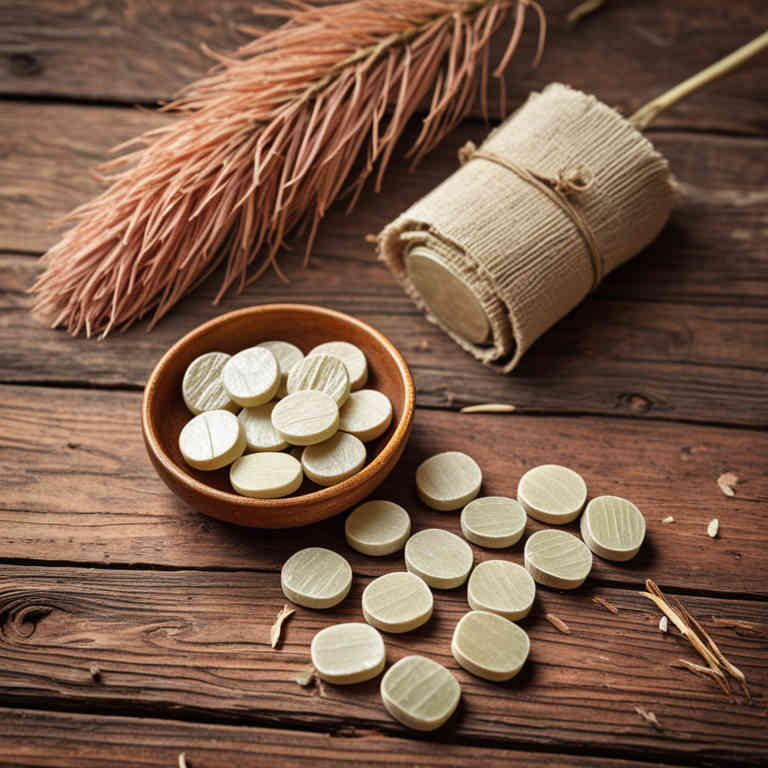
Cymbopogon citratus herbal lozenges are used to alleviate symptoms of respiratory conditions such as sore throat, cough, and bronchitis due to their antimicrobial and anti-inflammatory properties.
These lozenges contain essential oils derived from lemongrass, which have been traditionally used in herbal medicine to soothe irritated mucous membranes. The aromatic compounds in the lozenges can also help reduce nausea and promote a sense of freshness in the mouth and throat. Additionally, they may support immune function by providing natural antioxidants that help combat oxidative stress.
Because of their mild and natural composition, cymbopogon citratus lozenges are often preferred as a safer alternative to conventional over-the-counter remedies.
43. Satureja hortensis
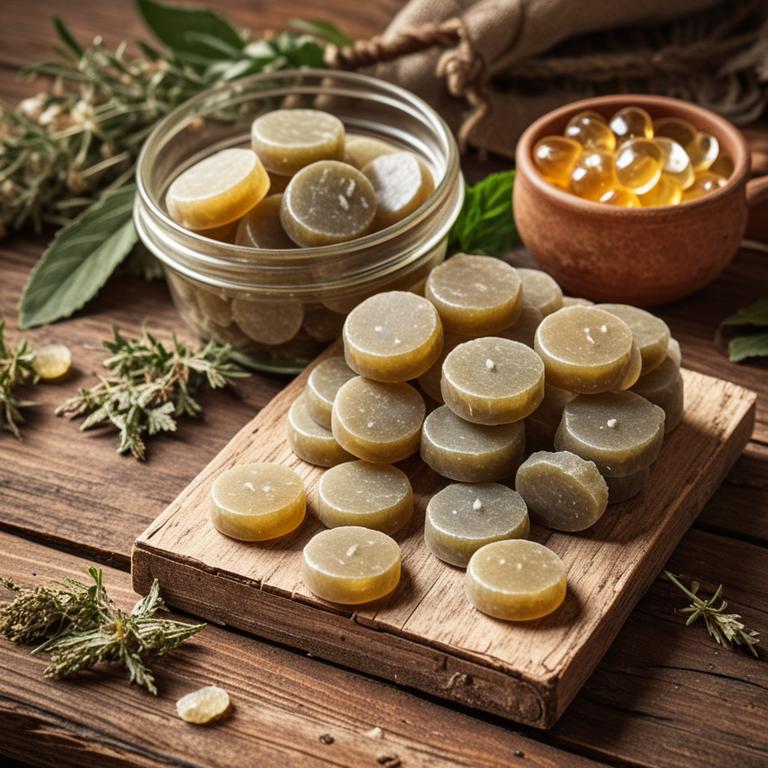
Satureja hortensis herbal lozenges are used to soothe sore throats and alleviate symptoms of respiratory infections.
These lozenges contain the essential oil of savory, which has natural antimicrobial and anti-inflammatory properties. The aromatic compounds in satureja hortensis help to reduce throat irritation and promote a sense of relief. They are particularly beneficial for individuals suffering from coughs, colds, or seasonal allergies.
Their pleasant flavor also makes them an appealing option for regular use without causing gastrointestinal discomfort.
44. Piper methysticum

Piper methysticum herbal lozenges are used to support respiratory health by soothing sore throats and reducing inflammation in the throat and airways.
These lozenges contain kava, which has been traditionally used for its calming and anti-inflammatory properties. They may also help alleviate symptoms of colds, coughs, and other respiratory infections due to their antimicrobial and analgesic effects. The natural ingredients in these lozenges provide a gentle alternative to over-the-counter medications, making them appealing for those seeking holistic remedies.
Overall, piper methysticum herbal lozenges offer a combination of traditional wisdom and natural healing properties that can support overall wellness.
45. Allium sativum
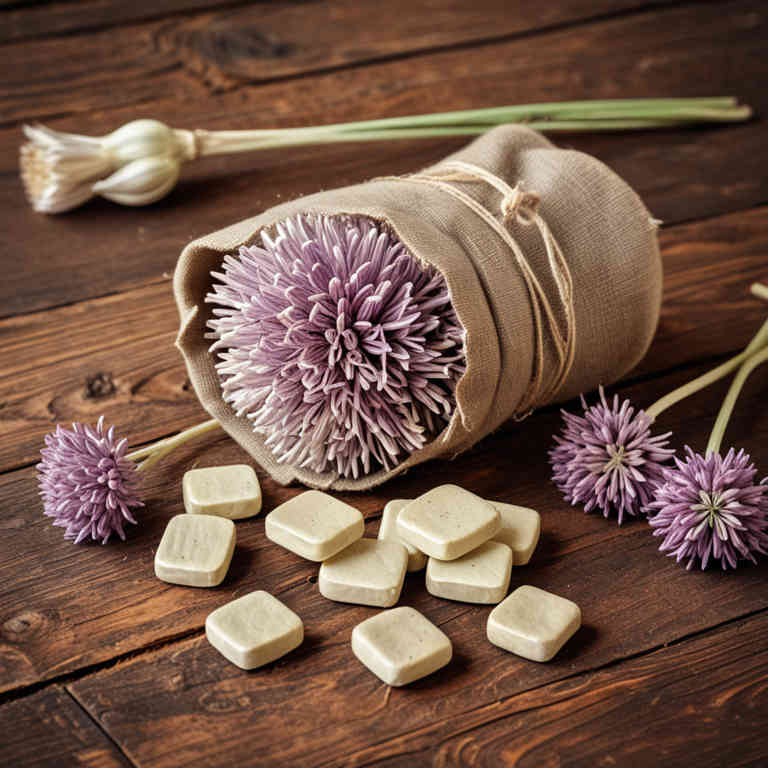
Allium sativum herbal lozenges are used to alleviate symptoms of respiratory infections such as sore throat and cough due to their antimicrobial and anti-inflammatory properties.
These lozenges help reduce throat irritation and inflammation by soothing the mucous membranes, making them a popular choice for individuals suffering from colds or flu. The active compounds in garlic, such as allicin, contribute to their ability to fight off bacteria and viruses that cause respiratory ailments. Additionally, they can enhance immune function, supporting the body's natural defenses against infections.
Their natural formulation makes them a preferred option for those seeking alternative or complementary treatments for minor throat discomfort.
46. Plantago ovata

Plantago ovata herbal lozenges are used to soothe sore throats and reduce inflammation in the mouth.
These lozenges contain psyllium husk, which has natural mucilage properties that help coat and protect the throat. They are particularly beneficial for individuals suffering from colds, flu, or chronic throat irritation. The herbal formulation provides a gentle and natural remedy without the side effects of conventional medications.
Their soothing effect makes them a popular choice for those seeking alternative or complementary treatments for throat discomfort.
47. Artemisia vulgaris

Artemisia vulgaris herbal lozenges are used to soothe sore throats and alleviate symptoms of respiratory infections due to their antiseptic and anti-inflammatory properties.
These lozenges contain artemisia, a herb known for its ability to reduce swelling and combat bacterial growth in the throat. They are particularly beneficial for individuals suffering from coughs, colds, or minor throat irritations, offering a natural alternative to conventional remedies. The aromatic compounds in artemisia also provide a refreshing sensation, making the lozenges more palatable and encouraging regular use.
Overall, artemisia vulgaris herbal lozenges are a valuable option for those seeking herbal support for throat and respiratory health.
48. Plantago lanceolata
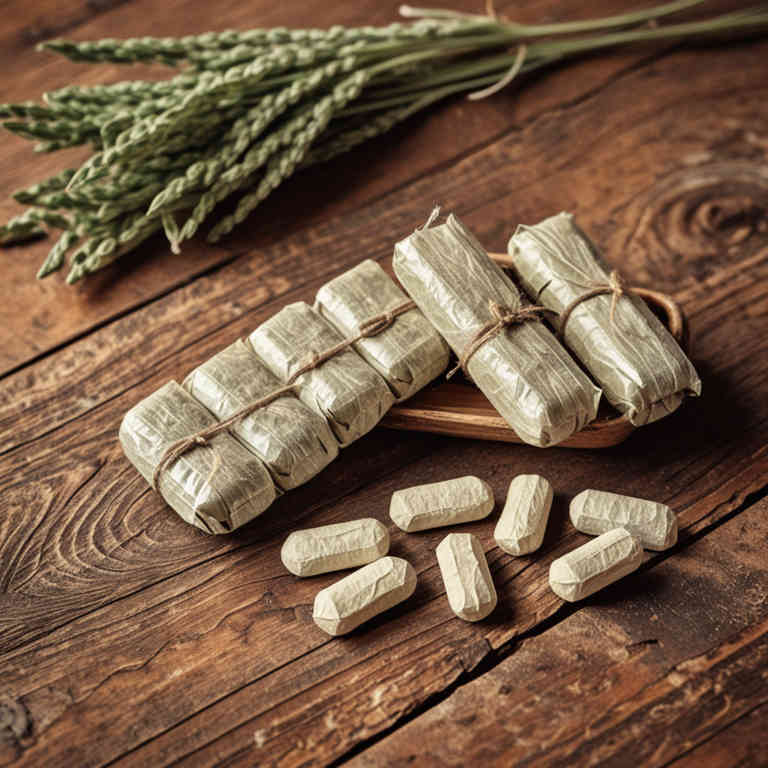
Plantago lanceolata herbal lozenges are used to soothe sore throats and alleviate symptoms of respiratory irritation.
These lozenges contain extracts from the plantain herb, which is known for its anti-inflammatory and antimicrobial properties. The mucilage in plantago lanceolata forms a protective layer over the throat, reducing pain and irritation. They are particularly beneficial for individuals suffering from coughs, colds, or tonsillitis.
Due to their natural composition, these lozenges offer a gentle and effective alternative to conventional throat medications.
49. Prunus domestica

Prunus domestica herbal lozenges are used to soothe sore throats and reduce inflammation in the respiratory tract.
These lozenges contain a variety of beneficial compounds, including antioxidants and flavonoids, which help combat oxidative stress and support immune function. They are particularly effective in alleviating symptoms of common colds, flu, and other mild respiratory infections. The herbal formulation also promotes saliva production, which can help lubricate the throat and ease discomfort.
Due to their natural composition and minimal side effects, prunus domestica lozenges are a safe and effective option for both adults and children seeking natural relief from throat irritation.
50. Hydrastis canadensis
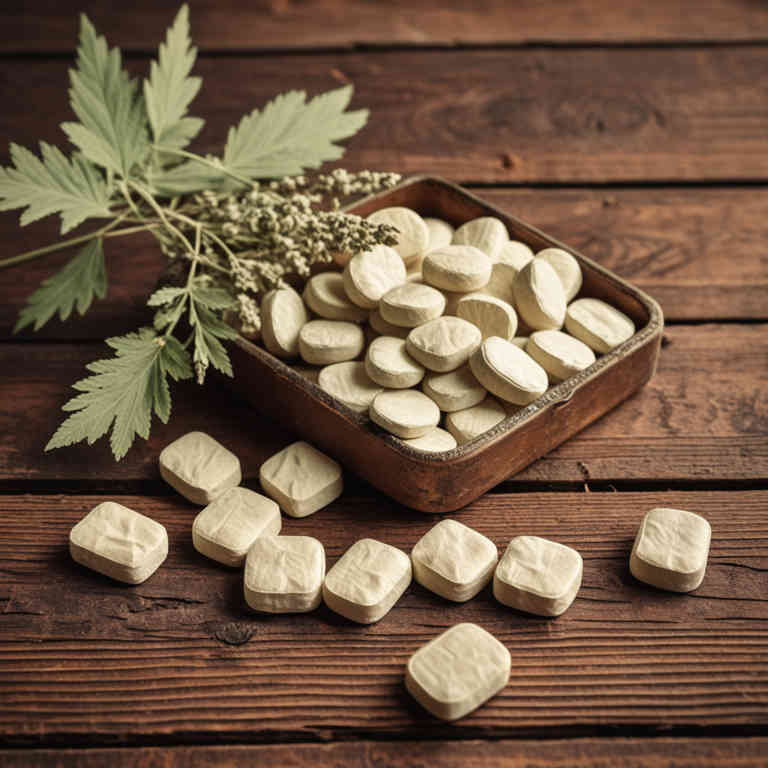
Hydrastis canadensis herbal lozenges are used to support respiratory health by soothing sore throats and reducing inflammation.
These lozenges contain goldenseal, a traditional herbal remedy known for its antimicrobial and anti-inflammatory properties. They are particularly beneficial for individuals experiencing frequent throat infections or irritation due to environmental factors. The natural compounds in goldenseal may help combat bacteria and viruses that contribute to throat discomfort.
As a complementary therapy, these lozenges offer a natural alternative for those seeking relief without relying on synthetic medications.
51. Sutherlandia frutescens
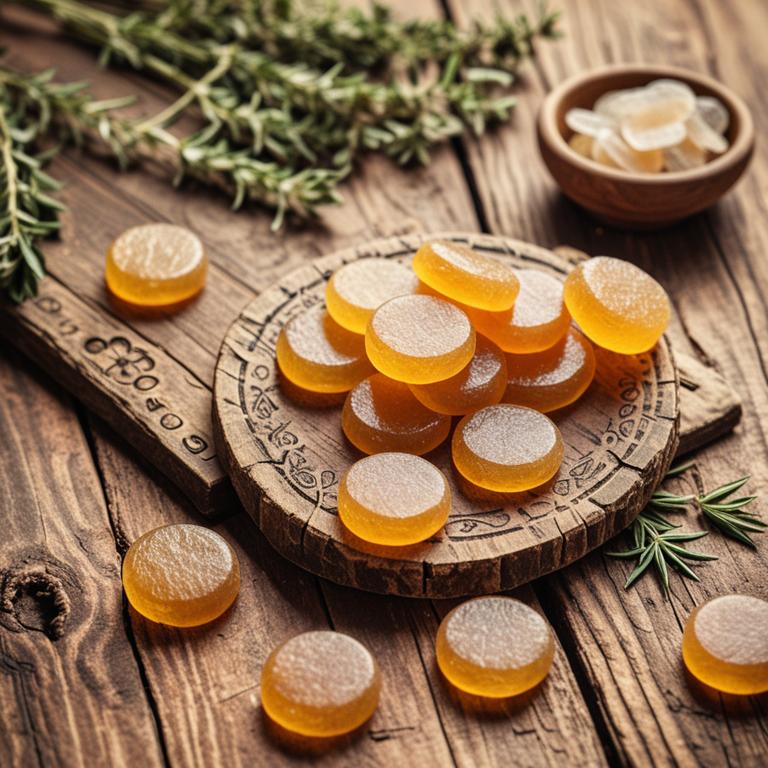
Sutherlandia frutescens herbal lozenges are used to support the immune system and alleviate symptoms associated with stress and fatigue.
These lozenges are often recommended for individuals experiencing chronic fatigue syndrome or those under prolonged emotional or physical stress. The herb is believed to contain compounds that may enhance the body's natural defenses and promote overall well-being. Additionally, they are used to soothe sore throats and reduce inflammation in the respiratory tract.
Due to their natural composition, these lozenges are considered a gentle and holistic option for supporting health during times of challenge.
52. Agrimonia eupatoria
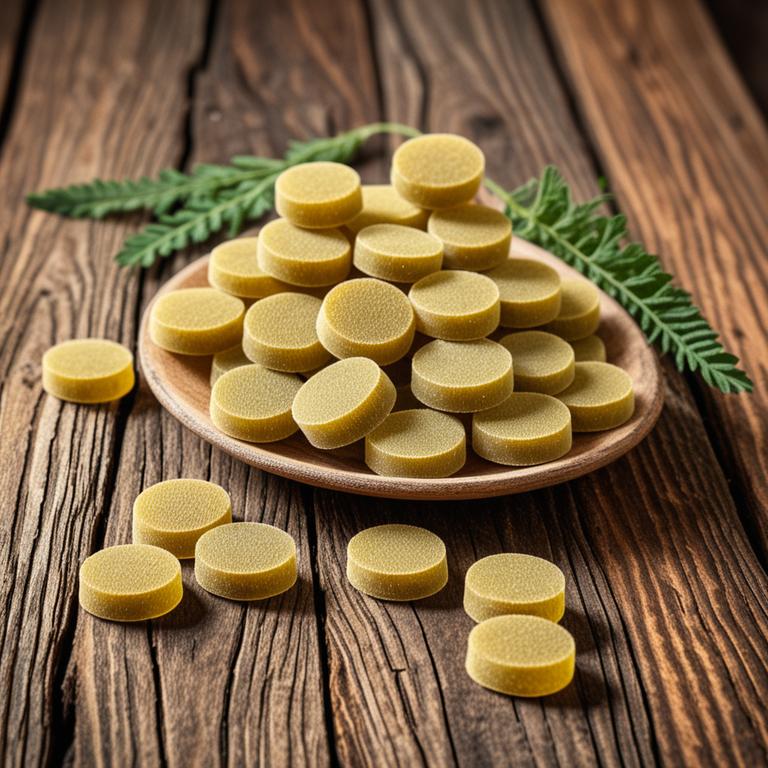
Agrimonia eupatoria herbal lozenges are used to soothe sore throats and alleviate symptoms of respiratory infections due to their anti-inflammatory and antimicrobial properties.
These lozenges contain a blend of agrimonia eupatoria, a herb known for its high concentration of flavonoids and tannins, which help reduce inflammation and fight harmful bacteria. They are particularly beneficial for individuals suffering from chronic coughs, as they can help suppress excessive mucus production and ease irritation in the throat. The herbal formulation is also preferred by those seeking natural remedies over synthetic medications, making it a safe option for long-term use.
Overall, agrimonia eupatoria herbal lozenges offer a gentle yet effective way to support respiratory health and provide relief from common throat discomforts.
53. Rhodiola rosea
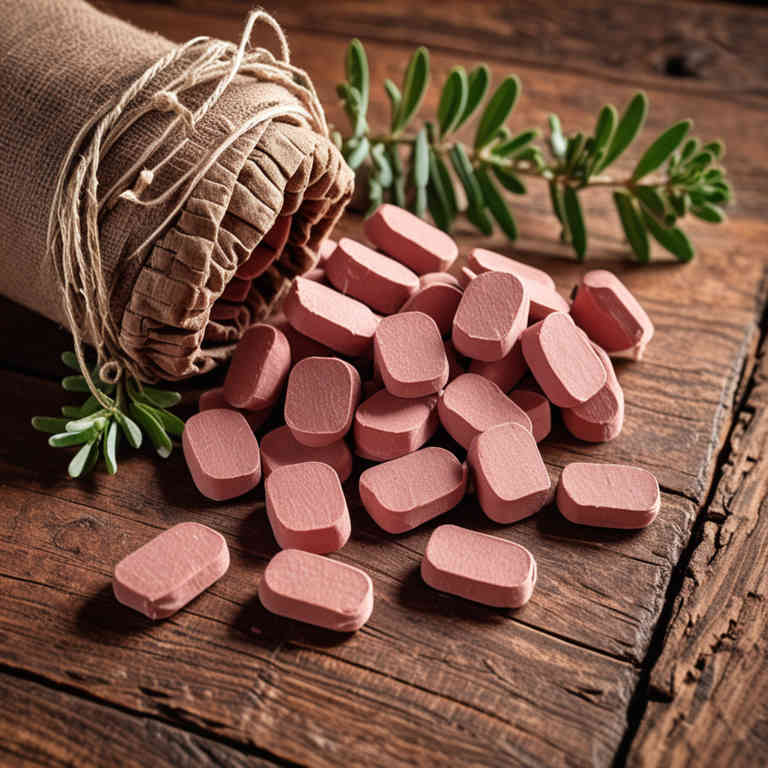
Rhodiola rosea herbal lozenges are used to support energy levels and reduce fatigue by enhancing the body's ability to cope with stress.
These lozenges contain adaptogenic compounds that help regulate the body's stress response, making them beneficial for individuals experiencing mental or physical exhaustion. They are also used to improve cognitive function and concentration, as rhodiola rosea has been shown to enhance mental clarity and focus. Additionally, the lozenges can soothe sore throats and provide a calming effect due to their natural herbal ingredients.
Overall, rhodiola rosea herbal lozenges are a convenient and effective way to incorporate adaptogenic support into daily wellness routines.
54. Paeonia suffruticosa
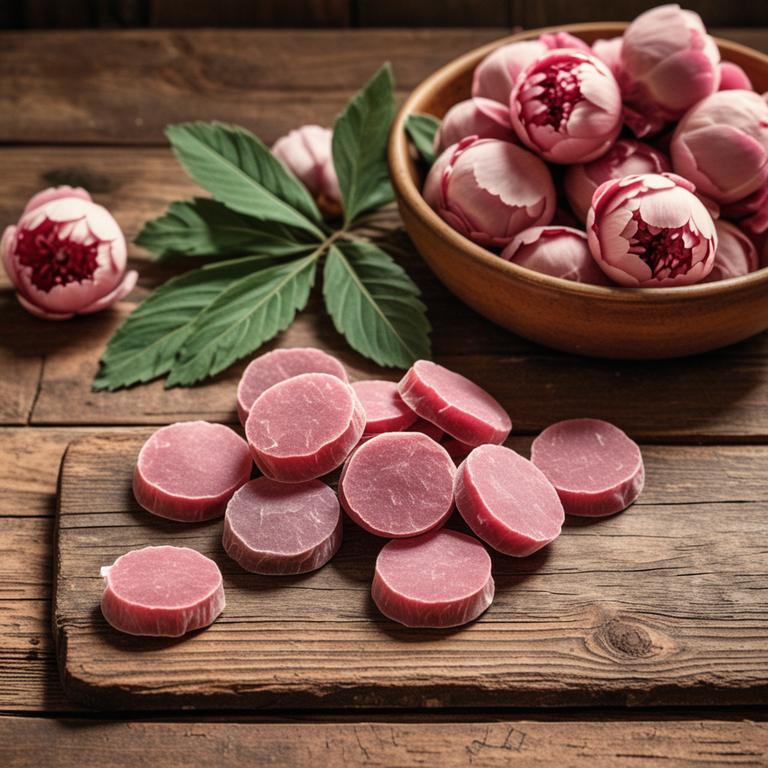
Paeonia suffruticosa herbal lozenges are used to soothe sore throats and alleviate symptoms of respiratory infections due to their anti-inflammatory and antiseptic properties.
These lozenges contain extracts from the roots of the peony plant, which have been traditionally valued in Chinese medicine for their ability to reduce irritation and promote healing in the throat. The active compounds in paeonia suffruticosa, such as paeoniflorin, help to reduce swelling and fight off harmful bacteria that may contribute to throat infections. They are particularly beneficial for individuals experiencing chronic coughing or persistent throat pain.
Their natural formulation makes them a safer alternative to conventional throat medications, especially for those seeking herbal remedies with fewer side effects.
55. Tribulus terrestris
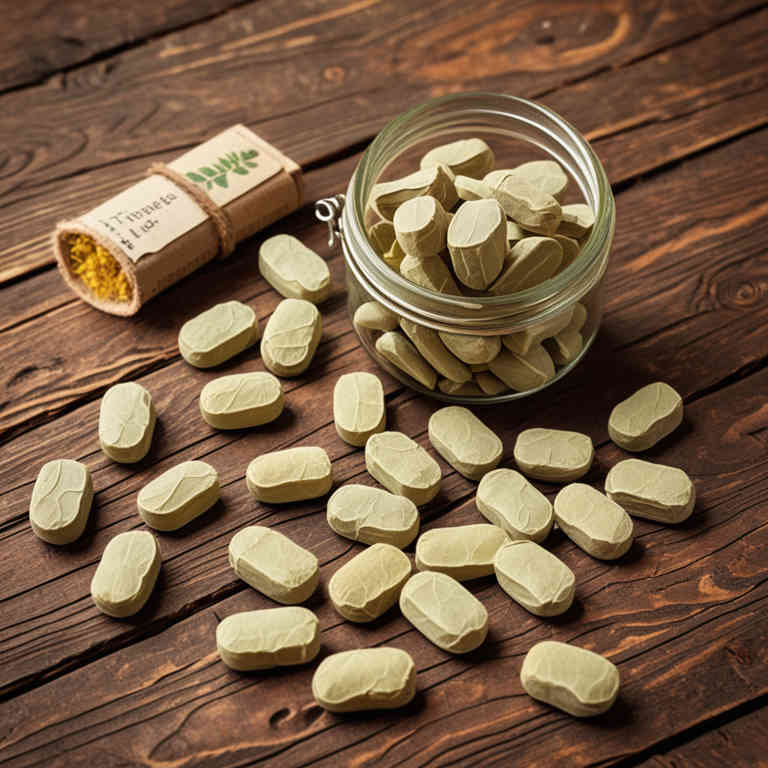
Tribulus terrestris herbal lozenges are used to support respiratory health by helping to reduce coughing and soothe throat irritation.
They are believed to contain natural compounds that may help alleviate symptoms of colds, sore throats, and other respiratory ailments. These lozenges are often recommended for individuals seeking natural remedies for throat discomfort without the use of synthetic medications. The herbal formulation is designed to provide a gentle and soothing effect on the throat lining.
Additionally, they may offer a calming effect that can help ease the discomfort associated with frequent throat clearing or irritation.
56. Calendula officinalis

Calendula officinalis herbal lozenges are used to soothe sore throats and reduce inflammation in the mouth and throat.
These lozenges contain calendula extract, which has anti-inflammatory and antimicrobial properties that help combat infections and irritation. They are particularly beneficial for individuals suffering from colds, flu, or other respiratory conditions that cause throat discomfort. The natural ingredients in these lozenges provide a gentle and safe alternative to over-the-counter medications, especially for children and those with sensitive systems.
Regular use of calendula officinalis herbal lozenges can also promote healing and prevent further irritation of the mucous membranes.
57. Lepidium meyenii
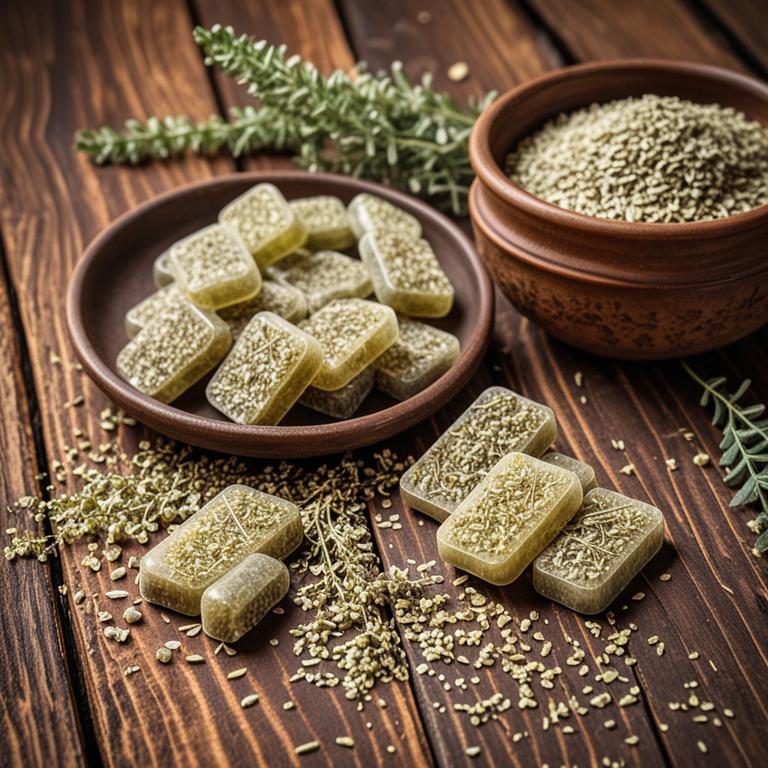
Lepidium meyenii herbal lozenges are used to support respiratory health by alleviating symptoms of coughs and sore throats due to their anti-inflammatory and soothing properties.
These lozenges are often made from maca root, which is rich in nutrients and antioxidants that can enhance overall immune function. They are particularly beneficial for individuals experiencing fatigue or stress, as maca is known to improve energy levels and mood. The slow release of the active compounds in the lozenges allows for prolonged relief, making them a convenient option for regular use.
Additionally, their natural formulation appeals to those seeking alternative or complementary remedies without synthetic additives.
58. Origanum vulgare
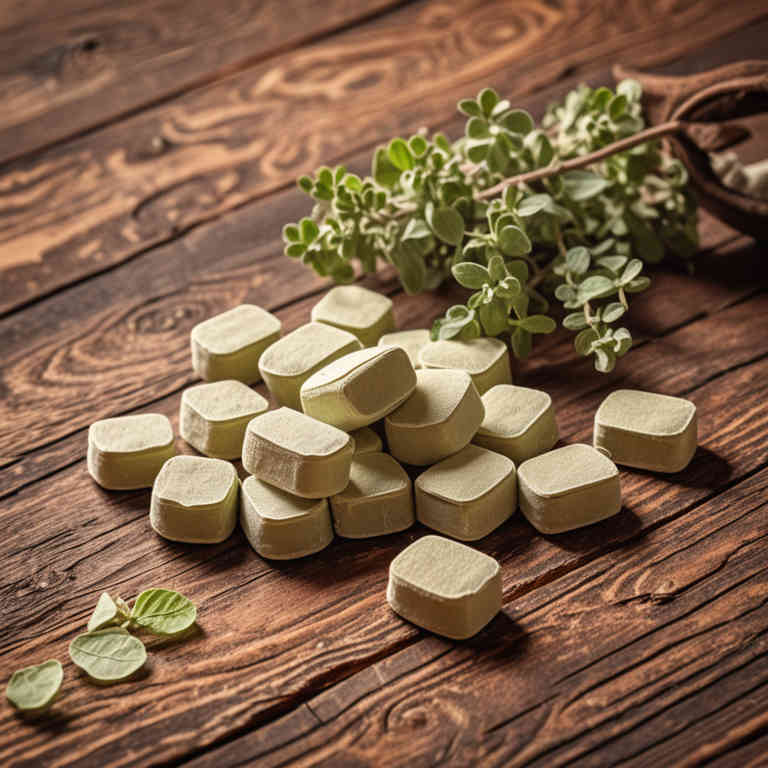
Origanum vulgare herbal lozenges are used to soothe sore throats and alleviate symptoms of respiratory infections.
These lozenges contain thymol, a compound known for its antimicrobial and anti-inflammatory properties, which helps reduce throat irritation and combat bacterial infections. They are often recommended for individuals suffering from colds, coughs, or tonsillitis due to their natural expectorant and decongestant effects. The aromatic compounds in origanum vulgare also provide a pleasant sensory experience, making the lozenges both effective and enjoyable to use.
Overall, these lozenges offer a natural and safe alternative for managing throat discomfort and supporting respiratory health.
59. Vitex negundo
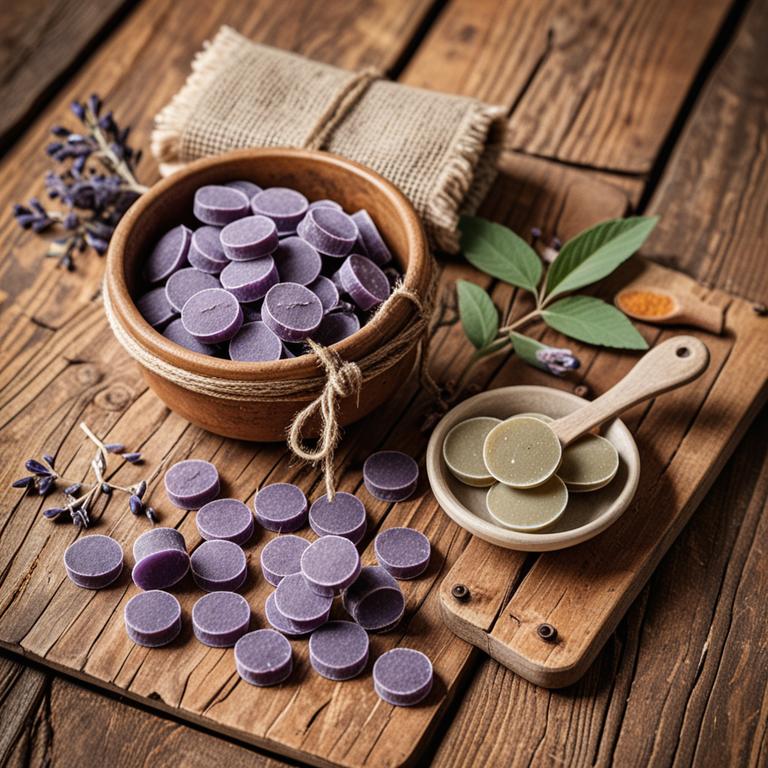
Vitex negundo herbal lozenges are used to soothe sore throats and alleviate symptoms of respiratory tract infections.
These lozenges contain natural compounds that have antimicrobial and anti-inflammatory properties, making them effective in reducing irritation and inflammation in the throat. They are particularly beneficial for individuals suffering from coughs, colds, or tonsillitis due to their ability to provide localized relief. The herbal formulation of Vitex negundo also supports immune function, helping the body fight off infections more effectively.
Overall, these lozenges offer a natural and safe alternative for those seeking relief from throat discomfort without relying on synthetic medications.
60. Symphytum officinale
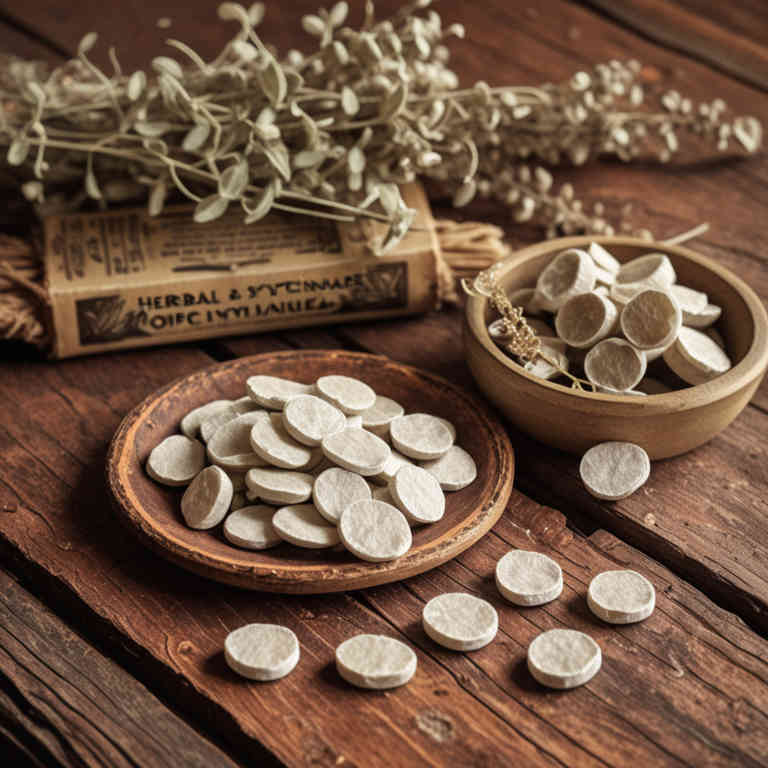
Symphytum officinale herbal lozenges are used to support the healing of minor wounds and irritations in the mouth and throat.
These lozenges contain the active ingredient, symphytum, which has traditionally been used for its anti-inflammatory and soothing properties. They are particularly beneficial for individuals experiencing sore throats, mouth ulcers, or gum inflammation due to their ability to reduce pain and promote tissue repair. The natural formulation makes them a preferred choice for those seeking alternative or complementary remedies.
Additionally, their ease of use and pleasant taste make them suitable for both adults and children.
61. Ocimum sanctum

Ocimum sanctum herbal lozenges are used to soothe sore throats and relieve symptoms of respiratory infections due to their antimicrobial and anti-inflammatory properties.
These lozenges contain holy basil, which is known for its ability to reduce inflammation and boost the immune system. They are particularly beneficial for individuals suffering from colds, coughs, and throat irritation, as they provide a natural and effective way to alleviate discomfort. The herbal formulation also helps in reducing mucus production and promoting faster recovery from respiratory ailments.
Overall, ocimum sanctum herbal lozenges are a safe and natural alternative for managing common throat and respiratory issues.
62. Anethum graveolens

Anethum graveolens herbal lozenges are used to soothe sore throats and alleviate symptoms of respiratory discomfort.
These lozenges contain the essential oil of fennel, which has natural anti-inflammatory and antiseptic properties. They are commonly used to reduce coughing and ease the irritation of the throat lining. The warming effect of the lozenges can also help to loosen mucus and improve breathing.
Due to their gentle and natural formulation, they are suitable for both adults and children seeking relief from mild throat infections or cold symptoms.
63. Nelumbo nucifera
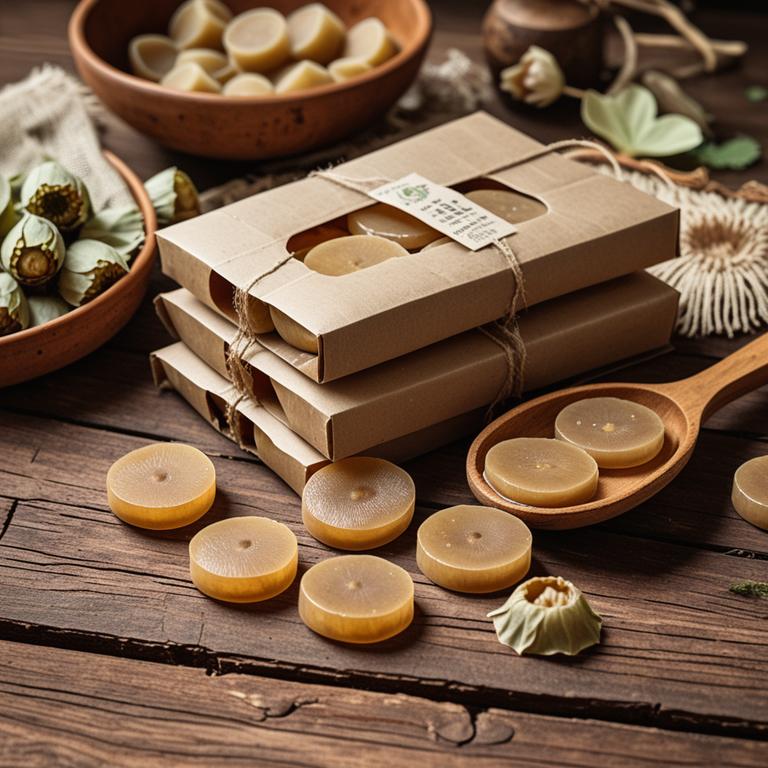
Nelumbo nucifera herbal lozenges are used to soothe sore throats and alleviate symptoms of respiratory infections due to their anti-inflammatory and antimicrobial properties.
These lozenges are traditionally made from the leaves and flowers of the sacred water lily, which have been used in Ayurvedic medicine for centuries. The natural ingredients in the lozenges help reduce throat irritation and promote healing by moisturizing the mucous membranes. They are also believed to support immune function and may help prevent the spread of viral infections.
Because of their gentle yet effective formulation, they are suitable for both adults and children seeking natural relief from minor throat discomfort.
64. Rhus toxicaria
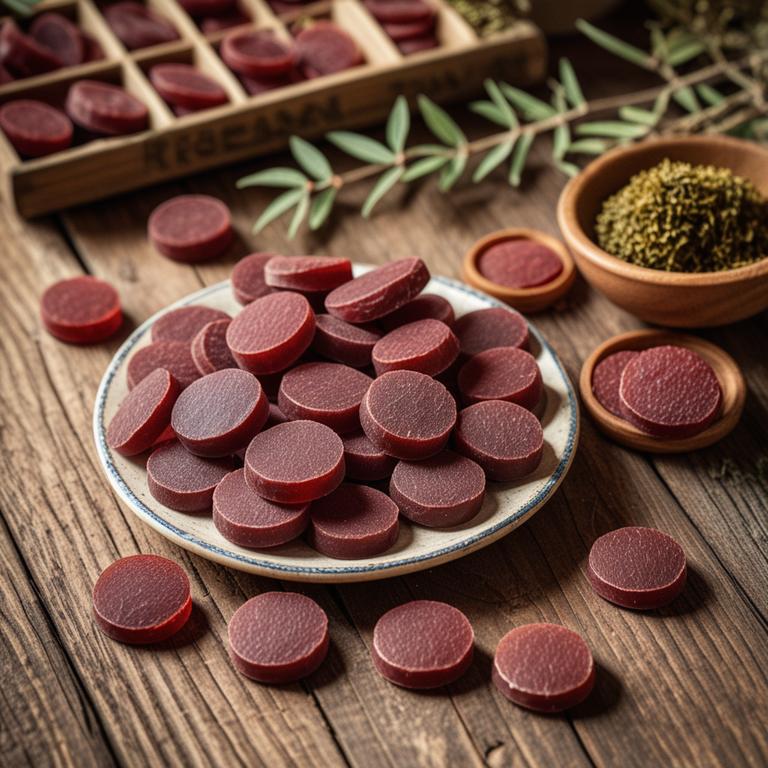
Rhus toxicaria herbal lozenges are used to alleviate symptoms of respiratory infections such as coughs, sore throats, and congestion by their expectorant and anti-inflammatory properties.
They help to loosen mucus and reduce throat irritation, making them beneficial for individuals suffering from colds or bronchitis. These lozenges are also known to provide soothing relief by numbing the throat and reducing pain associated with inflammation. Their natural ingredients make them a preferred choice for those seeking alternative or complementary treatments.
Overall, rhus toxicaria herbal lozenges are valued for their ability to support respiratory health and ease discomfort without the side effects of conventional medications.
65. Althaea officinalis
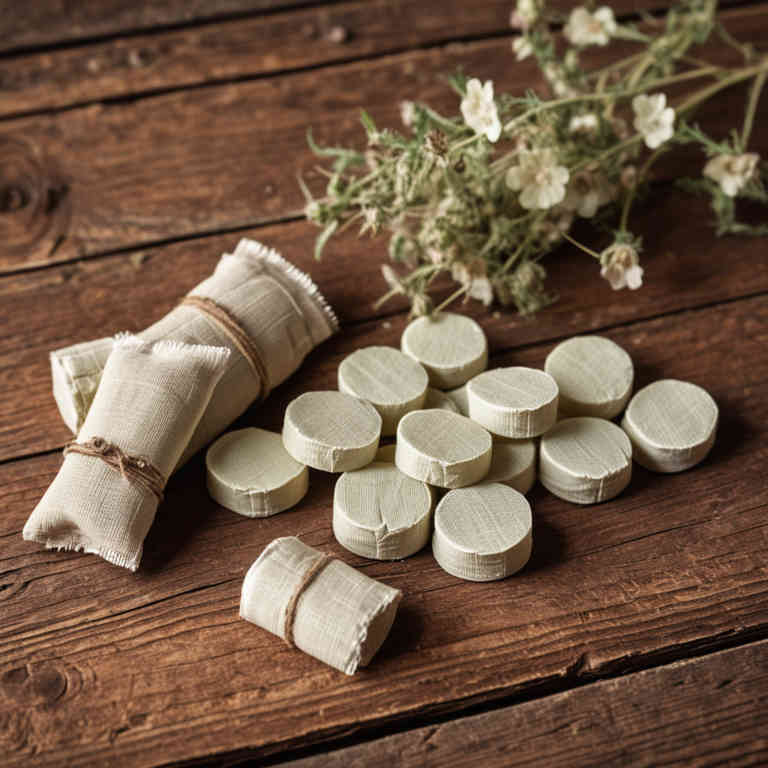
Althaea officinalis herbal lozenges are used to soothe sore throats and relieve symptoms of respiratory infections.
These lozenges contain mucilage, a thick, gel-like substance that coats the throat and reduces irritation. The soothing properties of althaea officinalis make it effective for alleviating dryness and inflammation in the throat. Additionally, they may help to loosen mucus and ease coughing, making them beneficial for people with colds or bronchitis.
Due to their natural composition, these lozenges are often preferred by individuals seeking gentle, non-pharmaceutical relief for throat discomfort.
66. Panax ginseng

Panax ginseng herbal lozenges are used to support immune function and enhance overall vitality.
These lozenges contain ginseng, a traditional herbal remedy known for its adaptogenic properties that help the body cope with stress. They are often recommended for individuals experiencing fatigue, mental fog, or weakened immunity. The slow release of ginseng compounds through lozenges allows for prolonged absorption, maximizing their therapeutic effects.
Due to their convenient form and mild taste, panax ginseng herbal lozenges are a popular choice for daily use in promoting wellness and energy.
67. Crocus sativus

Crocus sativus herbal lozenges are used to soothe sore throats and alleviate symptoms of respiratory discomfort.
These lozenges contain saffron, which has natural anti-inflammatory and antioxidant properties that help reduce irritation and inflammation in the throat. They are also effective in freshening breath and providing a mild numbing effect, making them ideal for use during cold and flu season. The soothing properties of saffron can help ease coughing and promote easier breathing.
Due to their natural composition, these lozenges are considered a safe and gentle option for individuals seeking natural remedies for throat-related issues.
68. Santalum album
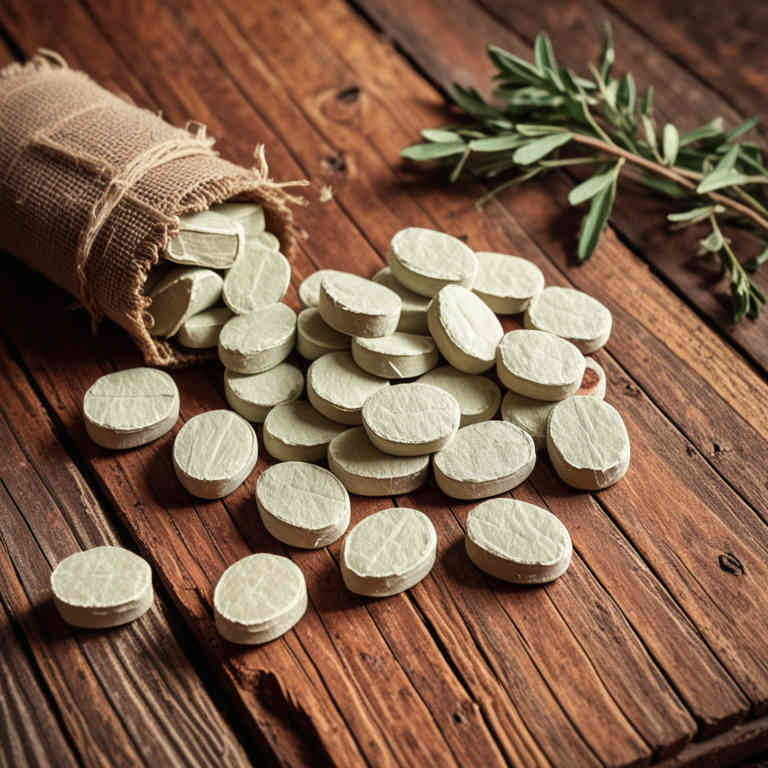
Santalum album herbal lozenges are used to alleviate symptoms of respiratory ailments such as coughs, sore throats, and inflammation in the throat.
These lozenges contain the essential oil of sandalwood, which has natural antiseptic and anti-inflammatory properties that help soothe irritated mucous membranes. The aromatic compounds in santalum album also provide a calming effect, making them beneficial for individuals experiencing stress-related throat discomfort. Additionally, the lozenges may support immune function by promoting a healthier respiratory environment.
Their gentle formulation makes them suitable for both adults and children, offering a natural alternative to conventional throat medications.
69. Cimicifuga racemosa
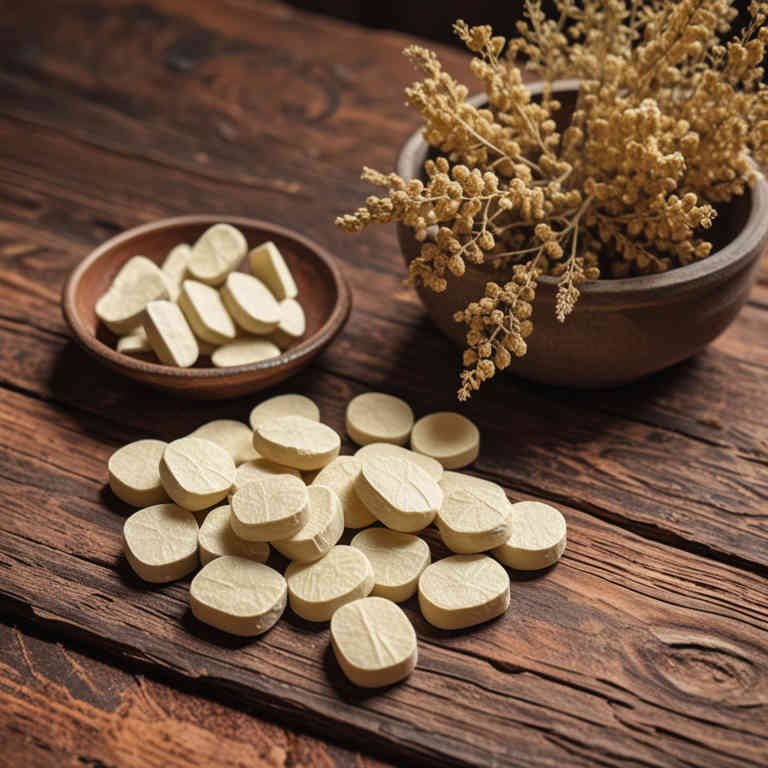
Cimicifuga racemosa herbal lozenges are used to alleviate symptoms of menopause, such as hot flashes, night sweats, and mood swings.
These lozenges contain the active compound actein, which is believed to help regulate hormonal balance in women. They are also used to support respiratory health by soothing sore throats and reducing inflammation in the airways. Due to their natural composition, they are often preferred by individuals seeking alternatives to conventional hormone replacement therapies.
The convenience of lozenge form makes them easy to use and effective for long-term management of menopausal symptoms.
70. Cyperus rotundus
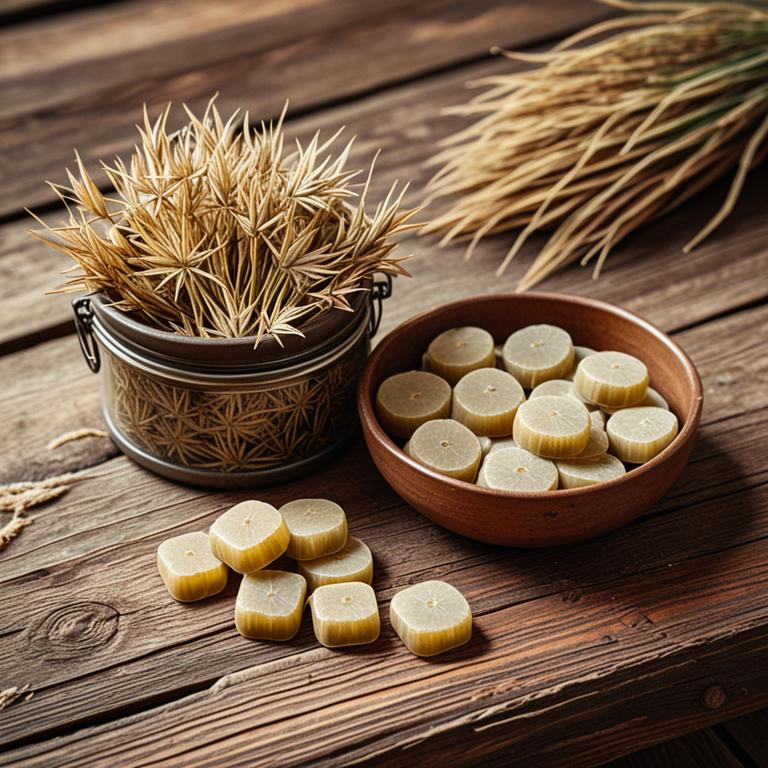
Cyperus rotundus herbal lozenges are used to relieve symptoms of sore throat and cough by their anti-inflammatory and antiseptic properties.
These lozenges help soothe irritated throat tissues and reduce mucus production, making them effective for respiratory discomfort. The natural compounds in Cyperus rotundus, such as flavonoids and tannins, contribute to their therapeutic effects. They are particularly beneficial for individuals seeking natural remedies without harsh chemicals.
Due to their mild and safe profile, these lozenges are suitable for both adults and children.
71. Leonurus cardiaca
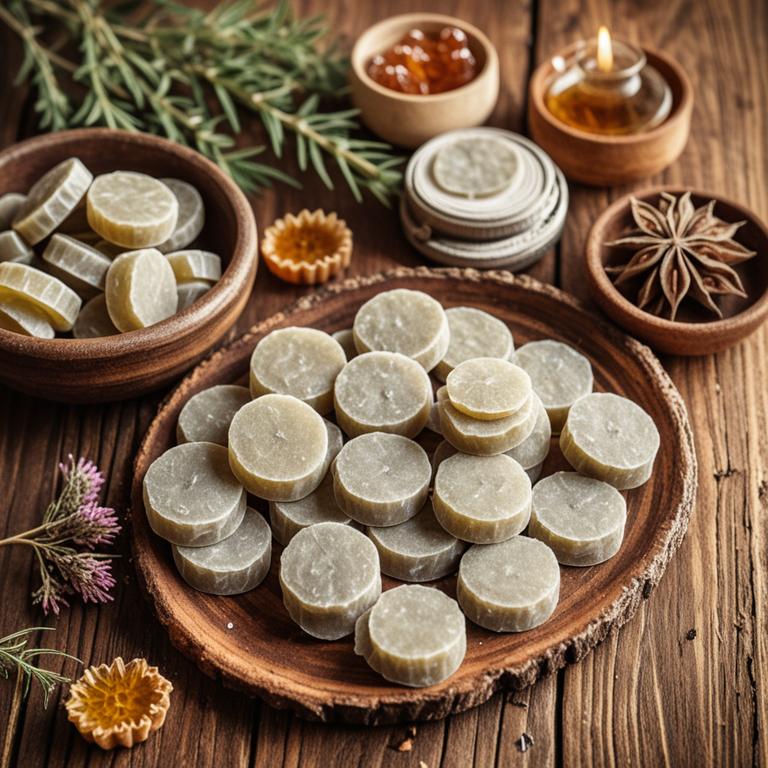
Leonurus cardiaca herbal lozenges are used to support respiratory health and alleviate symptoms of coughs and throat irritation.
These lozenges contain a blend of natural ingredients, including the herb Leonurus cardiaca, which has been traditionally valued for its soothing and anti-inflammatory properties. The formulation helps to reduce inflammation in the throat, making it easier to swallow and providing relief from soreness. Additionally, the lozenges may help to loosen mucus and improve overall respiratory comfort.
Their natural composition makes them a safe and gentle option for those seeking herbal remedies for minor respiratory ailments.
72. Nepeta cataria

Nepeta cataria herbal lozenges are used to soothe sore throats and alleviate symptoms of mild respiratory discomfort.
These lozenges contain catnip, a herb known for its calming and expectorant properties, which can help reduce irritation and inflammation in the throat. The aromatic compounds in catnip may also promote relaxation and ease breathing, making them beneficial for individuals experiencing mild congestion. Additionally, nepeta cataria has a mild sedative effect, which can help ease anxiety or restlessness associated with minor respiratory issues.
Overall, these lozenges offer a natural and gentle option for supporting respiratory comfort and overall well-being.
73. Solanum tuberosum

Solanum tuberosum herbal lozenges are used to soothe sore throats and alleviate symptoms of respiratory infections.
These lozenges contain compounds derived from the potato plant, which may have mild antimicrobial and anti-inflammatory properties. They are particularly beneficial for individuals suffering from mild coughs, colds, or throat irritations. The soothing effect of the lozenges can help reduce discomfort and promote easier swallowing.
Their natural formulation makes them a safe alternative for those seeking herbal remedies without harsh chemicals.
74. Strychnos nux-vomica
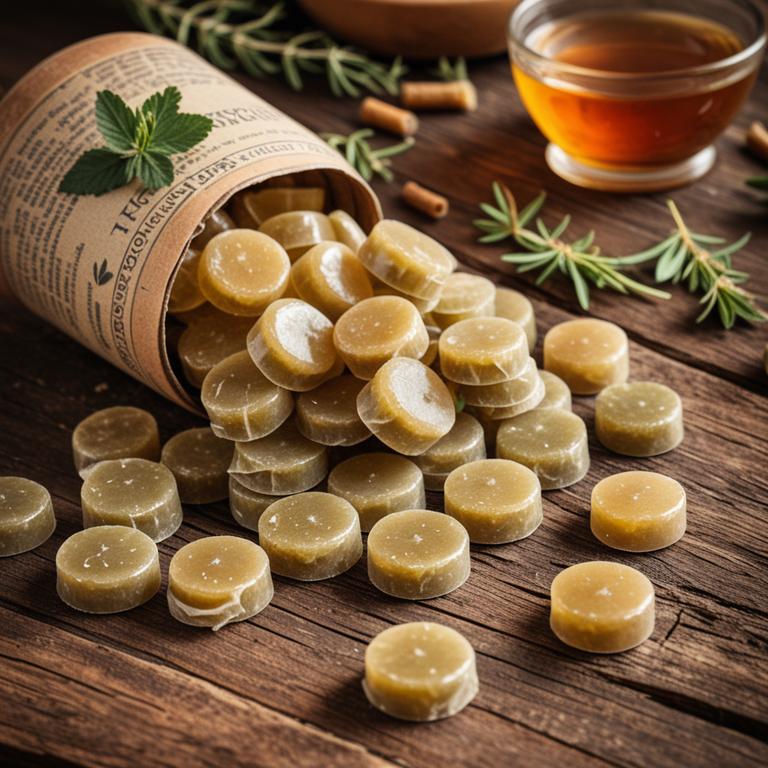
Strychnos nux-vomica herbal lozenges are used to relieve symptoms of respiratory conditions such as coughs and sore throats by promoting expectoration and reducing inflammation.
These lozenges are formulated with natural ingredients that have antitussive and anti-inflammatory properties, making them effective for soothing irritated mucous membranes. They are particularly beneficial for individuals suffering from chronic coughs or throat infections due to their ability to ease discomfort and support the body's natural healing process. The herbal composition of these lozenges also helps in boosting the immune system, aiding in faster recovery from respiratory ailments.
Due to their traditional medicinal roots and holistic approach, they are often preferred as a natural alternative to conventional cough suppressants.
75. Valeriana officinalis
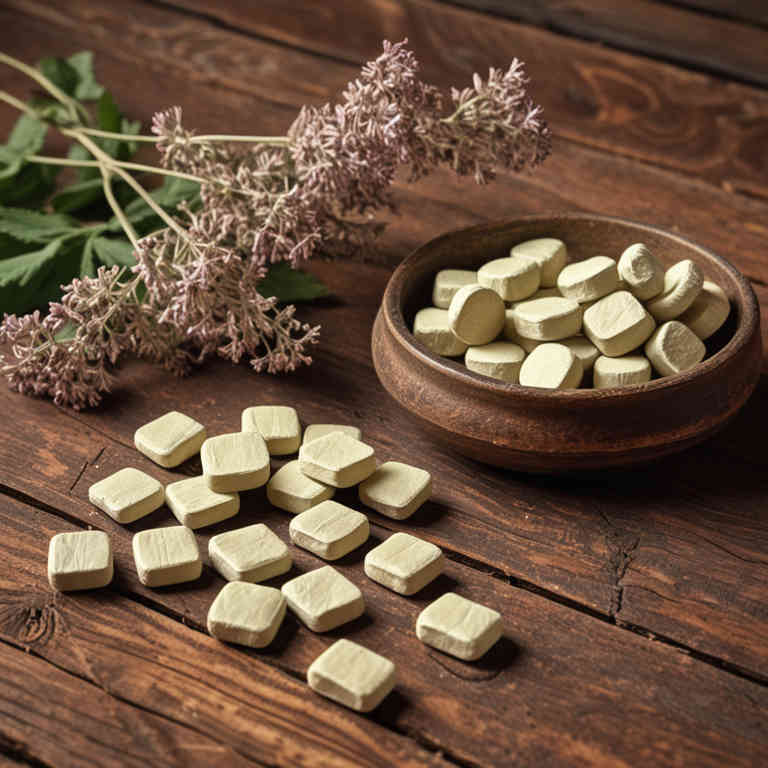
Valeriana officinalis herbal lozenges are used to alleviate symptoms of mild anxiety and stress-related insomnia by promoting relaxation and calming the nervous system.
These lozenges contain valerenic acid, which may help reduce the activity of stress hormones and improve sleep quality. They are often recommended as a natural alternative to pharmaceutical sedatives due to their mild side effect profile. The herbal formulation is also believed to support digestive health by soothing the gastrointestinal tract.
Overall, valeriana officinalis lozenges offer a holistic approach to managing stress and improving restful sleep without the risk of dependency.
76. Arnica montana
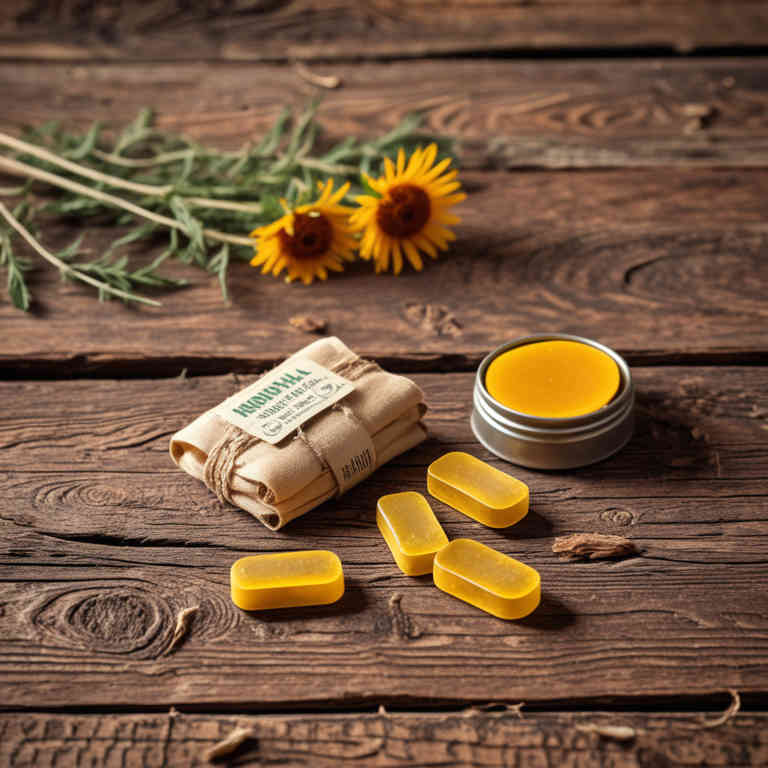
Arnica montana herbal lozenges are used to alleviate symptoms of sore throats and minor oral irritations due to their anti-inflammatory and analgesic properties.
These lozenges contain a concentrated form of arnica montana, a plant known for its ability to reduce swelling and pain. They are particularly beneficial for individuals suffering from colds, coughs, or gum inflammation, as they provide localized relief without systemic effects. The soothing action of arnica montana helps to reduce discomfort and promote healing in the throat and mouth area.
Additionally, they are often preferred as a natural alternative to over-the-counter pain relievers, making them a popular choice for those seeking herbal remedies.
77. Paeonia lactiflora
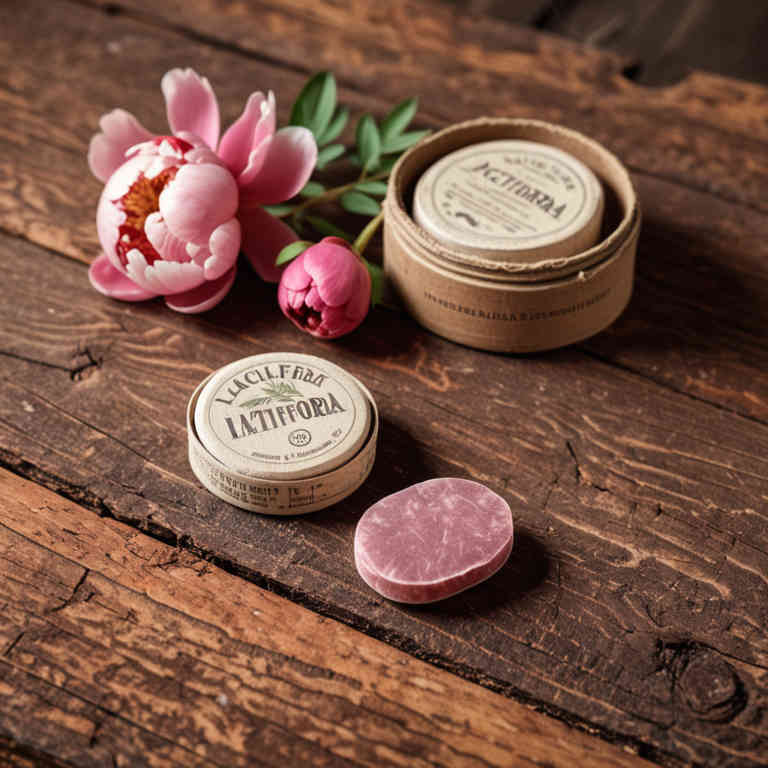
Paeonia lactiflora herbal lozenges are used to soothe sore throats and reduce inflammation in the respiratory tract.
These lozenges contain the active compound paeoniflorin, which has anti-inflammatory and analgesic properties that help alleviate discomfort. They are particularly effective for individuals suffering from colds, flu, or other viral infections that cause throat irritation. The natural formulation of these lozenges makes them a safe and gentle option for long-term use.
Additionally, they can help promote faster recovery by supporting the body’s natural healing processes.
78. Boswellia serrata
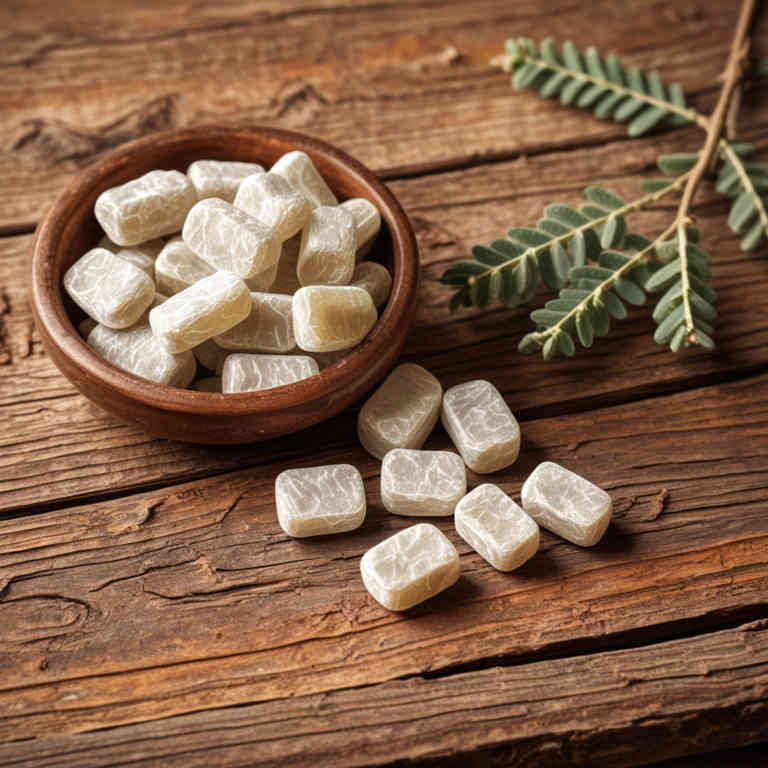
Boswellia serrata herbal lozenges are used to support respiratory health by reducing inflammation and soothing sore throats.
These lozenges contain boswellic acids, which have potent anti-inflammatory properties that can help alleviate symptoms of conditions like asthma and bronchitis. They are also beneficial for individuals suffering from frequent coughing or irritation in the throat, as they provide a natural and gentle way to relieve discomfort. The slow release of active compounds allows for prolonged relief, making them suitable for regular use throughout the day.
Overall, boswellia serrata herbal lozenges are a valuable option for those seeking natural remedies to improve respiratory comfort and reduce inflammation.
79. Vaccinium myrtillus
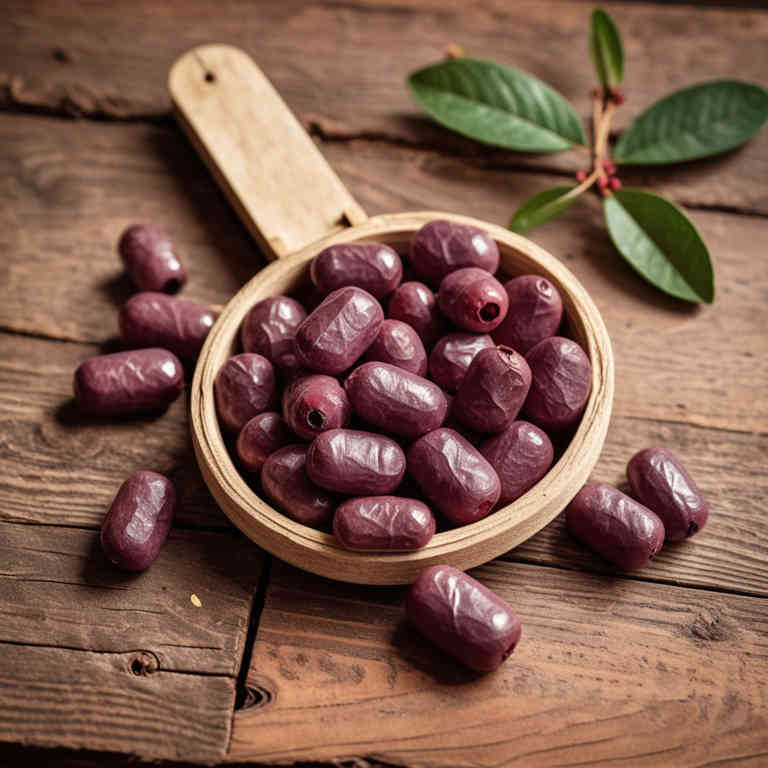
Vaccinium myrtillus herbal lozenges are used to support respiratory health by soothing sore throats and reducing inflammation.
These lozenges contain the active compound bearberry, which has antimicrobial and antiseptic properties that help fight off infections. They are particularly beneficial for individuals suffering from colds, flu, or chronic coughs due to their ability to alleviate throat irritation. The natural ingredients in these lozenges make them a safe alternative for those seeking herbal remedies without synthetic chemicals.
Their mild taste and easy dissolvability also make them suitable for regular use throughout the day.
80. Citrus aurantium
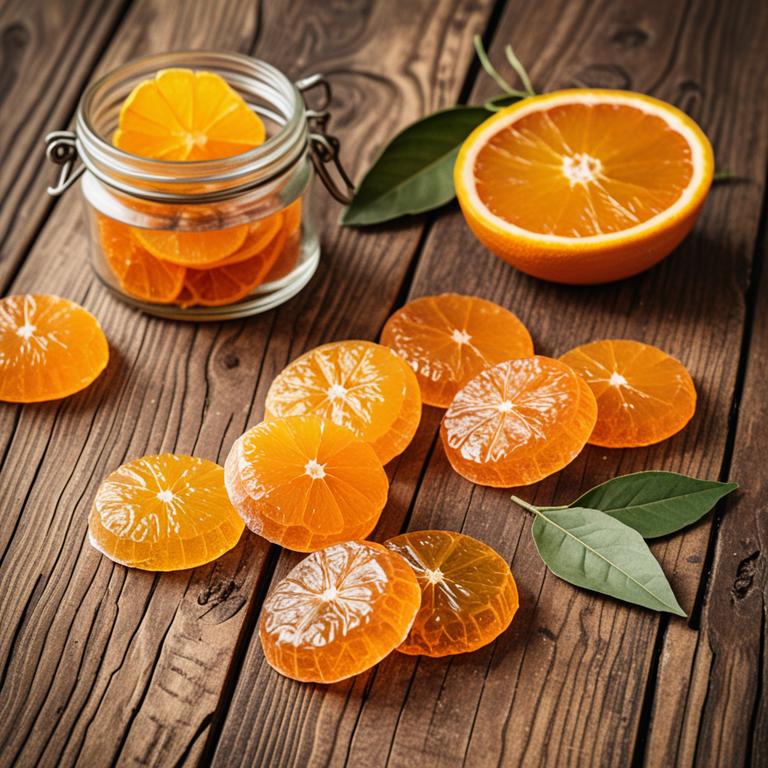
Citrus aurantium herbal lozenges are used to support respiratory health by alleviating symptoms of coughs and sore throats through their expectorant and antiseptic properties.
These lozenges contain bioactive compounds such as naringin and hesperidin, which have anti-inflammatory and antioxidant effects that help reduce irritation and inflammation in the throat. They are also beneficial for individuals seeking natural remedies to soothe minor throat discomfort without the use of synthetic medications. The pleasant citrus flavor makes them more palatable and encourages regular use, enhancing their effectiveness.
Overall, citrus aurantium herbal lozenges provide a safe and effective alternative for managing common respiratory ailments.
81. Tamarindus indica
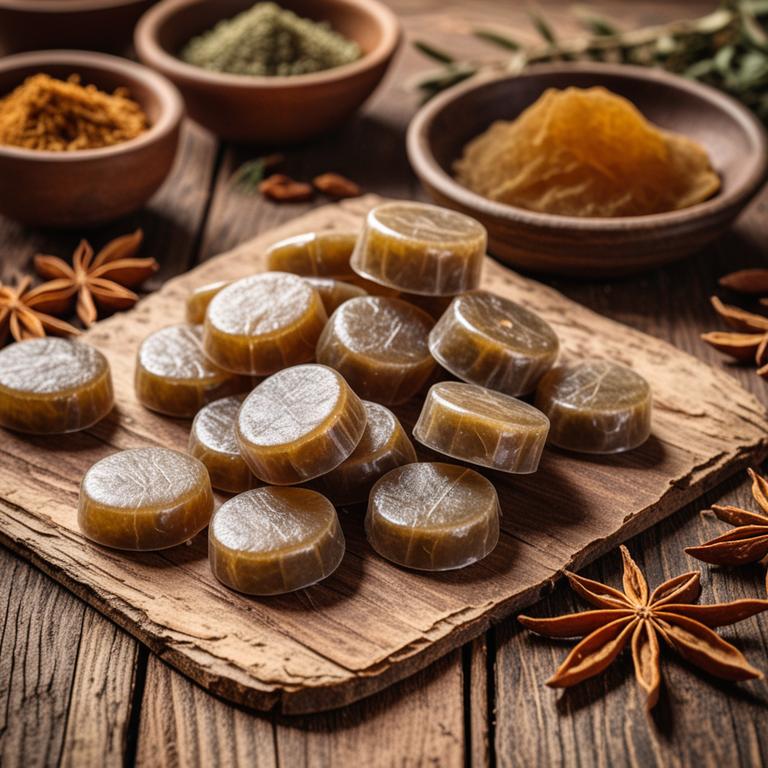
Tamarindus indica herbal lozenges are used to soothe sore throats and reduce inflammation due to their natural antiseptic and astringent properties.
These lozenges help alleviate symptoms of colds, coughs, and throat infections by providing a cooling effect that numbs pain and irritation. The high concentration of tannins in tamarind helps in reducing excess mucus and promoting healing of the throat lining. Additionally, they are often used to freshen breath and provide a pleasant taste during illness.
Their traditional use in herbal medicine highlights their effectiveness as a natural remedy for respiratory and throat-related discomfort.
82. Pueraria lobata

Pueraria lobata herbal lozenges are used to alleviate symptoms of menopause, such as hot flashes and night sweats, due to their phytoestrogen content.
These lozenges help regulate hormonal imbalances by mimicking the effects of estrogen in the body, providing natural relief without the side effects of synthetic hormones. They are also beneficial for reducing inflammation and improving respiratory health, making them suitable for individuals with chronic cough or sore throat. The convenience of lozenge form allows for easy consumption and prolonged contact with the throat, enhancing their therapeutic effects.
Overall, pueraria lobata herbal lozenges offer a safe and effective alternative for managing various health concerns related to hormonal changes and inflammation.
83. Artemisia annua

Artemisia annua herbal lozenges are used to support respiratory health by alleviating symptoms of colds, sore throats, and coughs due to their antiseptic and anti-inflammatory properties.
These lozenges contain artemisinin, a compound known for its potential antiviral and antimicrobial effects, which can help reduce the duration and severity of viral infections. They are also valued for their soothing effect on the throat, making them a natural remedy for irritations and discomfort. The herbal formulation is often preferred by individuals seeking alternative or complementary treatments to conventional medications.
Overall, artemisia annua lozenges offer a holistic approach to managing mild respiratory ailments with a focus on natural and gentle care.
84. Cymbopogon martinii
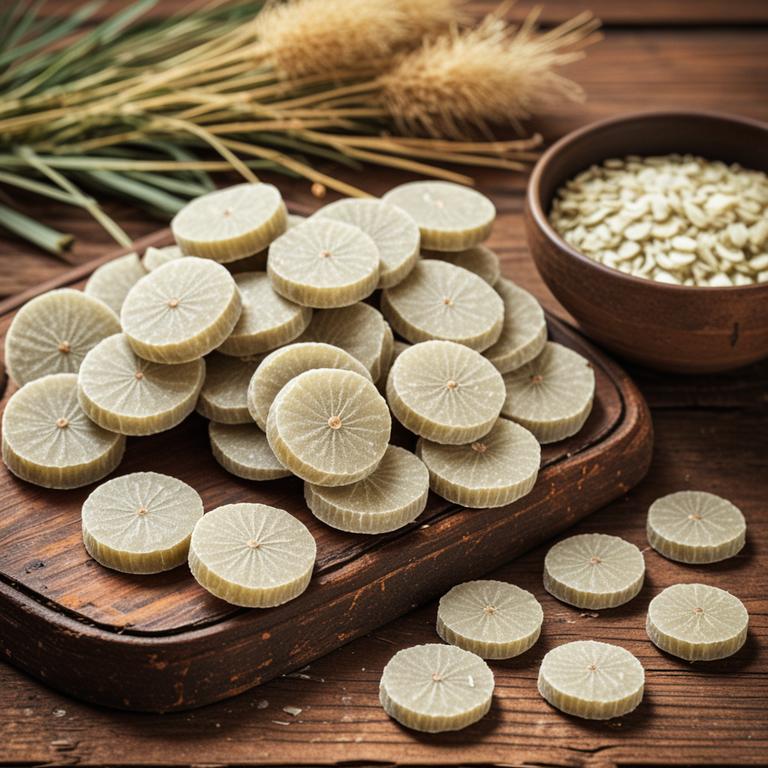
Cymbopogon martinii herbal lozenges are used to relieve symptoms of respiratory and oral discomfort, such as sore throat, cough, and inflammation.
These lozenges contain essential oils derived from the plant, which have natural antimicrobial and anti-inflammatory properties. The aromatic compounds in cymbopogon martinii help to soothe the throat and promote easier breathing by reducing mucus buildup. They are also beneficial for freshening breath and providing a calming effect due to their pleasant scent.
Because of these therapeutic benefits, they are often recommended as a natural alternative to conventional lozenges for those seeking holistic health solutions.
85. Salvia miltiorrhiza
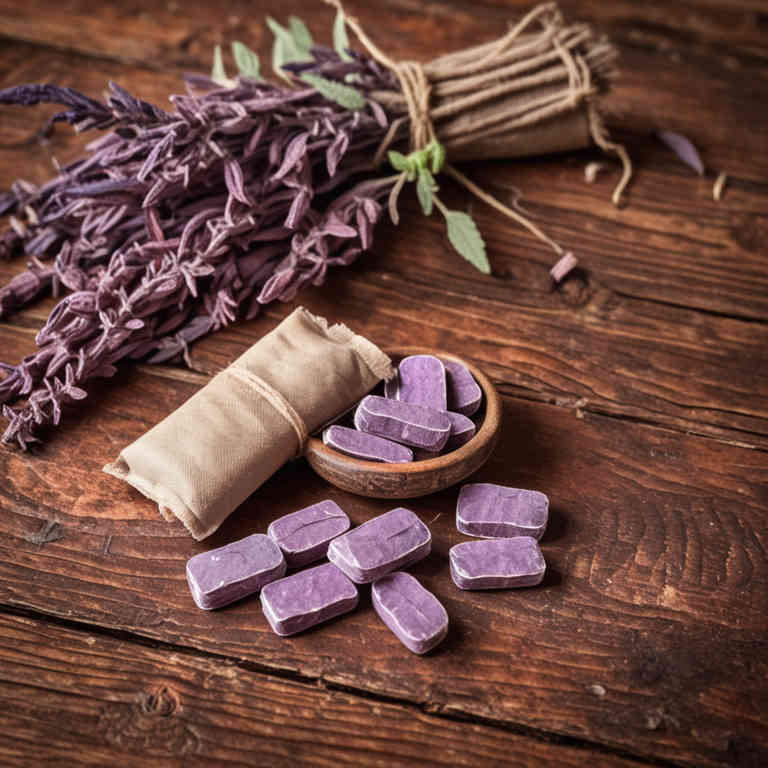
Salvia miltiorrhiza herbal lozenges are used to support respiratory health by soothing throat irritation and reducing inflammation.
These lozenges contain salvia miltiorrhiza, a traditional Chinese herb known for its anti-inflammatory and antioxidant properties. They are particularly beneficial for individuals suffering from sore throats, coughs, or other respiratory discomforts. The active compounds in the herb help to calm the mucous membranes and promote healing.
Due to their natural composition, these lozenges are often preferred as a gentle, alternative remedy for mild to moderate throat conditions.
86. Cinnamomum camphora
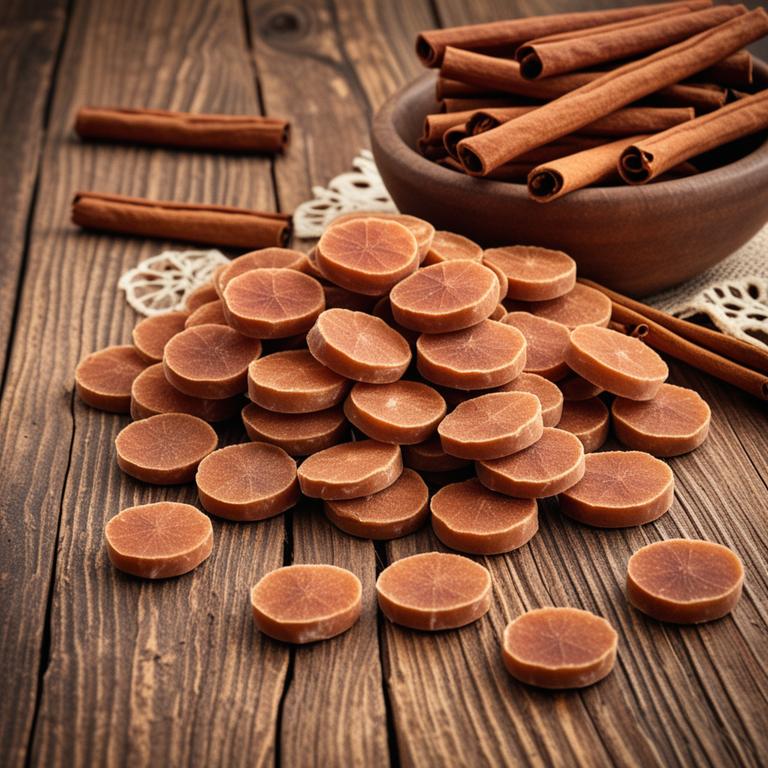
Cinnamomum camphora herbal lozenges are used to relieve symptoms of respiratory conditions such as sore throat, cough, and congestion.
These lozenges contain camphor, which has a cooling and analgesic effect that can soothe irritated mucous membranes. The natural aromatic compounds in cinnamomum camphora also help to open up the airways and ease breathing. Additionally, they are often used to reduce inflammation and fight off minor infections due to their antimicrobial properties.
Because of these benefits, they are a popular choice for people seeking natural remedies for throat discomfort and cold-related symptoms.
87. Syringa vulgaris

Syringa vulgaris herbal lozenges are used to soothe sore throats and reduce inflammation in the respiratory tract.
These lozenges contain extracts from the fragrant lilac plant, which is known for its antimicrobial and anti-inflammatory properties. The natural compounds in syringa vulgaris help to alleviate symptoms of colds, coughs, and minor throat irritations. They are particularly beneficial for individuals seeking natural remedies without synthetic additives.
Due to their calming effect and pleasant aroma, these lozenges are also used to improve overall comfort during respiratory discomfort.
88. Papaver rhoeas

Papaver rhoeas herbal lozenges are used to soothe sore throats and alleviate symptoms of colds and respiratory infections.
These lozenges contain the active ingredient poppy flower, which has natural anti-inflammatory and analgesic properties. The soothing effect of the lozenges helps reduce irritation and discomfort in the throat, making them ideal for frequent throat clearing or coughing. They are also beneficial for individuals who suffer from chronic throat conditions, providing a natural alternative to conventional medications.
Due to their mild and gentle formulation, papaver rhoeas herbal lozenges are suitable for both adults and children, offering a safe and effective remedy for common throat ailments.
89. Withania somnifera

Withania somnifera herbal lozenges are used to support respiratory health by soothing sore throats and reducing inflammation in the throat and respiratory tract.
These lozenges contain ashwagandha, an adaptogenic herb known for its ability to enhance immune function and reduce stress, which can indirectly improve overall respiratory wellness. They are also beneficial for individuals experiencing chronic cough or irritation due to their anti-inflammatory and antimicrobial properties. The herbal formulation provides a natural alternative for those seeking relief without synthetic medications.
Additionally, the lozenges offer a convenient and palatable way to incorporate the therapeutic benefits of withania somnifera into daily health routines.
90. Centella asiatica
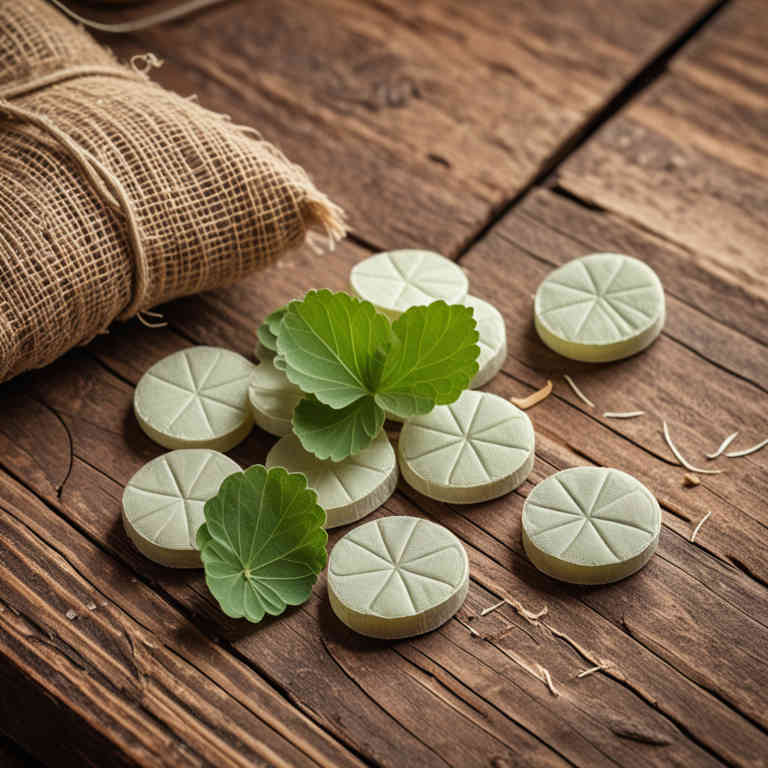
Centella asiatica herbal lozenges are used to support oral health and soothe sore throats due to their antiseptic and anti-inflammatory properties.
These lozenges contain centella asiatica, a traditional herb known for its ability to promote healing and reduce irritation in the mouth. They are particularly beneficial for individuals suffering from canker sores, gum inflammation, or other oral discomforts. The active compounds in centella asiatica help to strengthen the mucous membranes, enhancing the body's natural defenses against infections.
As a result, these lozenges are a natural and effective option for maintaining oral hygiene and comfort.
91. Avena sativa
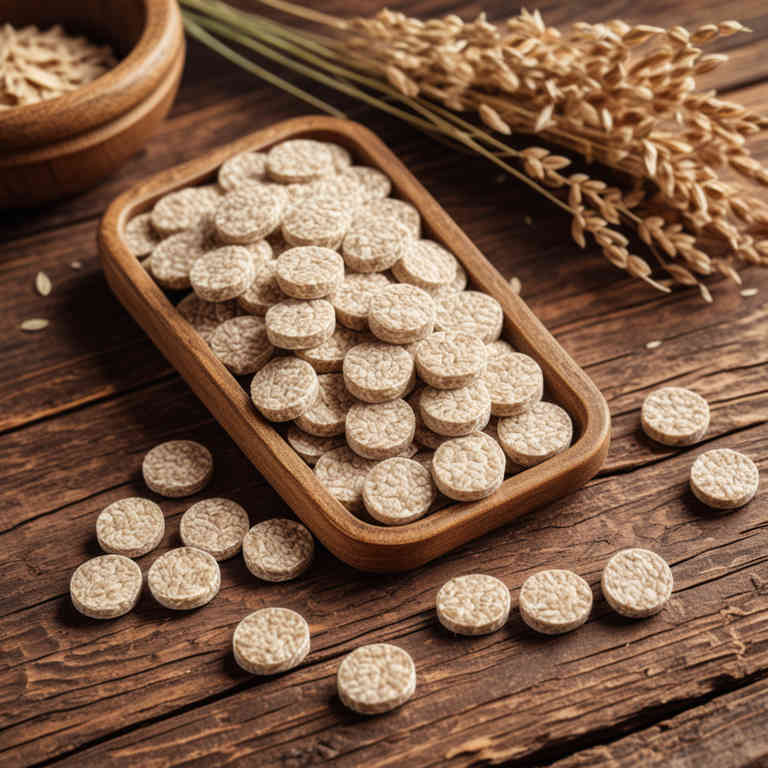
Avena sativa herbal lozenges are used to soothe sore throats and reduce inflammation in the throat and mouth.
These lozenges contain oat extract, which is known for its mild antiseptic and anti-inflammatory properties. They are particularly beneficial for individuals suffering from colds, flu, or other respiratory infections. The slow release of the herbal ingredients provides prolonged relief, making them an effective natural remedy for discomfort.
Additionally, avena sativa lozenges are gentle on the throat and can be used safely by both adults and children.
92. Tussilago farfara

Tussilago farfara herbal lozenges are used to soothe and alleviate symptoms of respiratory conditions such as coughs, sore throats, and bronchitis.
These lozenges contain the active ingredient coltsfoot, which has been traditionally valued for its expectorant and anti-inflammatory properties. The herb helps to loosen mucus in the airways, making it easier to expel and thus reducing the severity of coughing fits. They are particularly beneficial for individuals seeking natural remedies without harsh pharmaceutical side effects.
Due to their gentle yet effective action, tussilago farfara lozenges are a popular choice for both chronic and acute respiratory discomfort.
93. Papaver somniferum

Papaver somniferum herbal lozenges are used to provide relief from sore throat and other throat-related discomforts due to their anti-inflammatory and analgesic properties.
These lozenges contain compounds derived from opium poppy, which can help reduce inflammation and soothe irritation in the throat. They are often recommended for individuals suffering from colds, coughs, or infections that cause persistent throat pain. The slow release of active ingredients in the lozenges allows for prolonged relief, making them an effective option for managing symptoms at home.
However, their use should be cautious and under medical guidance due to the potential for dependency and side effects.
94. Hyssopus officinalis

Hyssopus officinalis herbal lozenges are used to soothe sore throats and alleviate symptoms of respiratory infections due to their antimicrobial and anti-inflammatory properties.
These lozenges contain essential oils like thymol and carvacrol, which help reduce bacterial growth and inflammation in the throat. They are particularly beneficial for individuals suffering from coughs, colds, or tonsillitis, as they provide a natural and gentle way to ease discomfort. The aromatic compounds in hyssopus officinalis also have a calming effect, making them useful for relieving stress-related throat irritation.
Overall, these lozenges offer a traditional yet effective remedy for maintaining throat health and supporting the immune system.
95. Eclipta prostrata
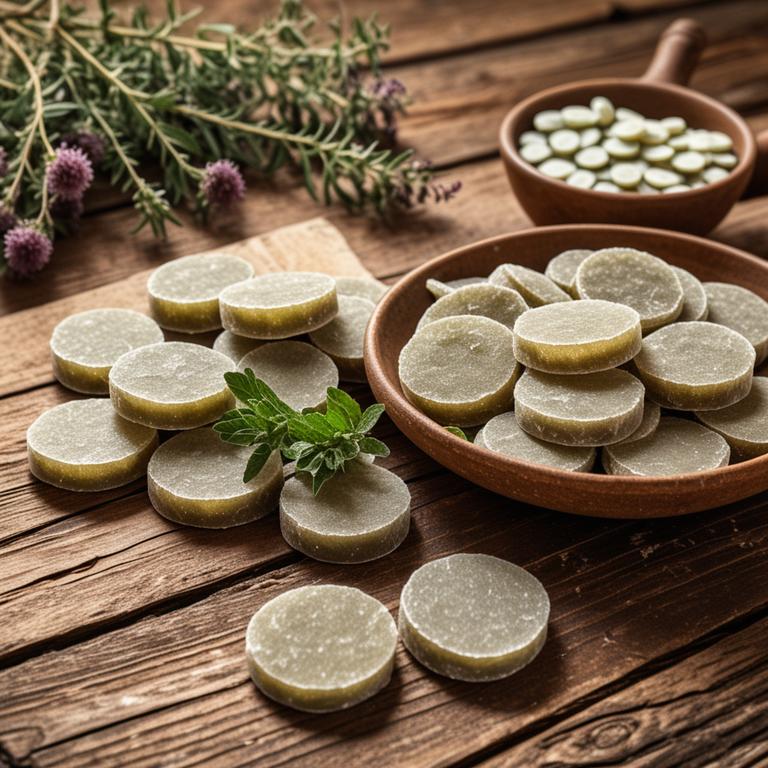
Eclipta prostrata herbal lozenges are used to soothe sore throats and alleviate symptoms of respiratory infections due to their anti-inflammatory and antimicrobial properties.
These lozenges contain extracts from the Eclipta prostrata plant, which is traditionally known for its healing effects on the respiratory system. The natural ingredients in the lozenges help reduce irritation and swelling in the throat, making them a popular choice for individuals suffering from coughs or colds. They are also believed to support immune function, enhancing the body's ability to fight off infections.
Overall, eclipta prostrata herbal lozenges offer a natural and effective remedy for throat discomfort and mild respiratory ailments.
96. Piper longum
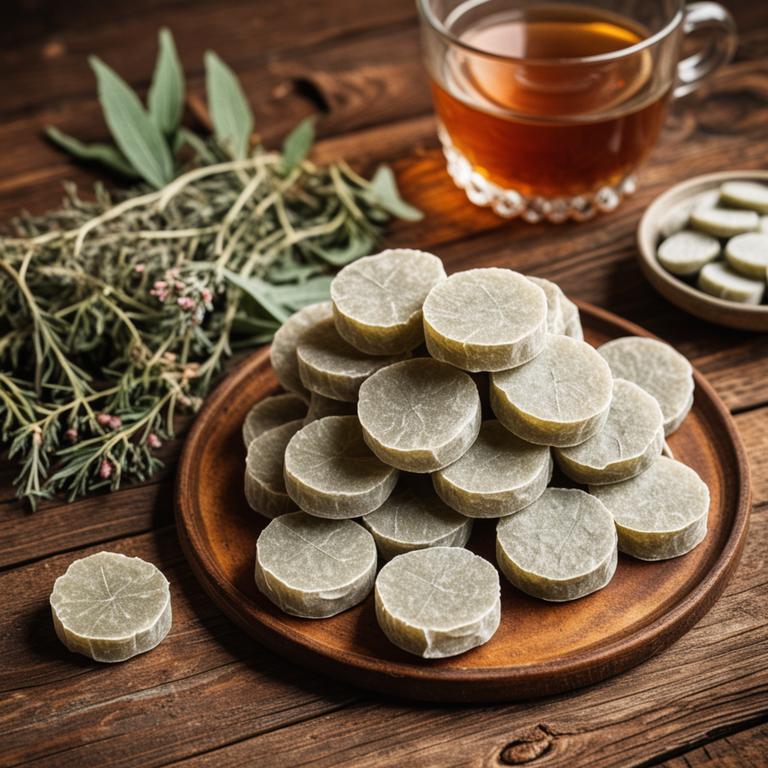
Piper longum herbal lozenges are used to relieve symptoms of respiratory tract infections such as cough, sore throat, and hoarseness due to their expectorant and anti-inflammatory properties.
These lozenges help in loosening mucus and making it easier to expel, which can alleviate congestion and promote clearer breathing. The active compounds in piper longum, such as piperine and alkaloids, have been traditionally used in Ayurvedic medicine for their soothing and healing effects on the throat. Regular use of these lozenges can also provide a sense of relief and comfort during bouts of throat irritation or inflammation.
Their natural formulation makes them a preferred choice for individuals seeking alternative or complementary treatments for common cold and flu symptoms.
97. Thuja occidentalis

Thuja occidentalis herbal lozenges are used to support respiratory health by alleviating symptoms of colds, coughs, and sore throats due to their antimicrobial and anti-inflammatory properties.
These lozenges help reduce mucus production and soothe irritated throat tissues, making them beneficial for those suffering from chronic or recurrent respiratory issues. The essential oils in thuja occidentalis, such as alpha-pinene and beta-pinene, contribute to their expectorant and decongestant effects. They are also believed to boost the immune system, helping the body fight off infections more effectively.
Because of these natural properties, thuja occidentalis lozenges are a popular alternative for individuals seeking herbal remedies for respiratory discomfort.
98. Melaleuca alternifolia
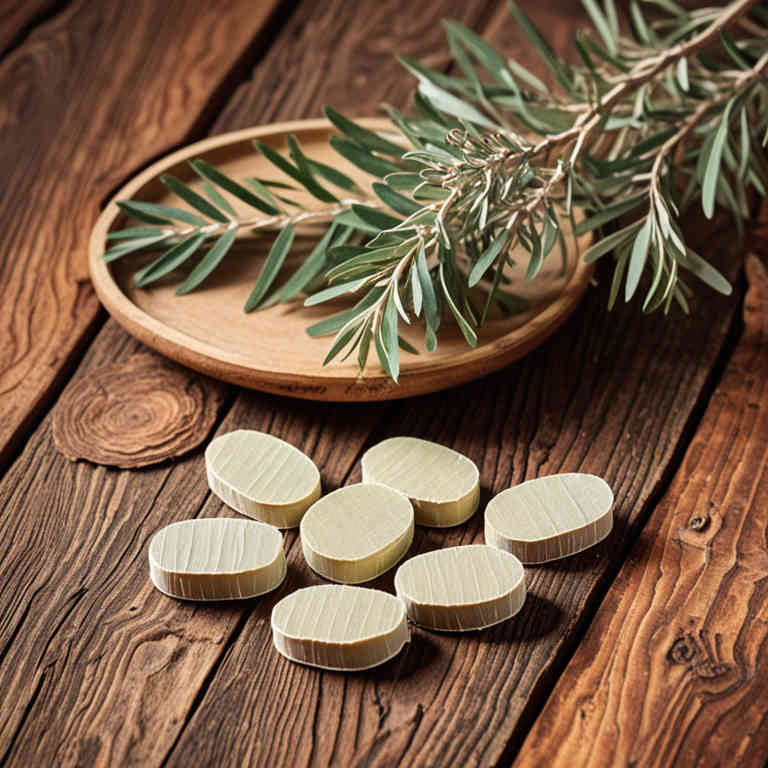
Melaleuca alternifolia herbal lozenges are used to alleviate symptoms of respiratory infections and sore throats due to their antimicrobial and anti-inflammatory properties.
These lozenges contain tea tree oil, which is known for its ability to combat bacteria and viruses that often cause throat irritation and coughing. The soothing effect of the lozenges helps reduce discomfort and promote faster healing of the throat lining. Additionally, they are often preferred as a natural alternative to over-the-counter medications, making them a popular choice for those seeking holistic remedies.
Their convenient form allows for easy use throughout the day, supporting continuous relief and comfort.
99. Cucurbita pepo
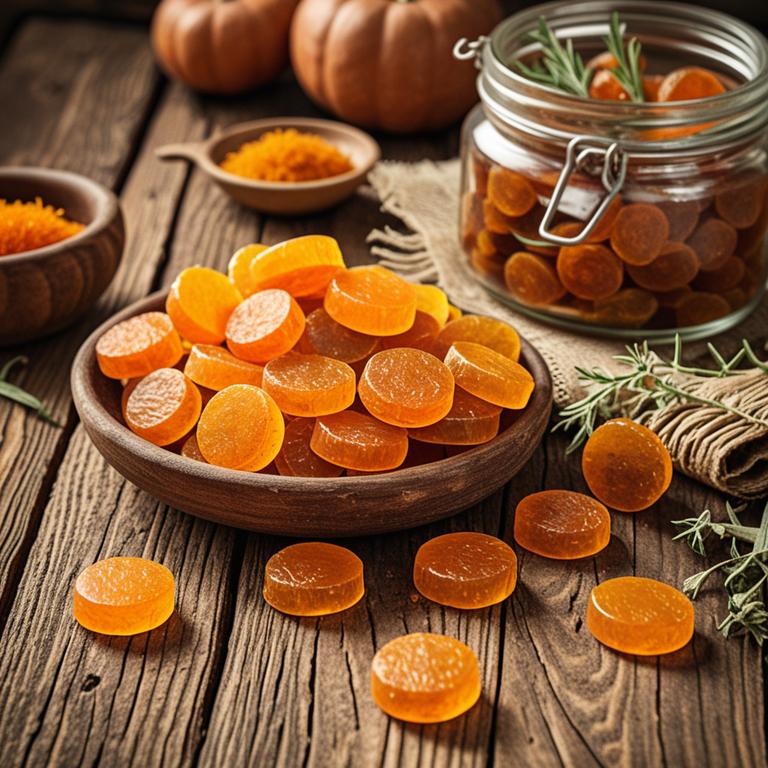
Cucurbita pepo herbal lozenges are used to soothe sore throats and alleviate symptoms of respiratory infections due to their anti-inflammatory and antimicrobial properties.
These lozenges contain compounds derived from the seeds and fruits of the cucumber and pumpkin plants, which have been traditionally used in herbal medicine. The natural ingredients in these lozenges help reduce irritation and inflammation in the throat, making them a gentle and effective remedy for minor throat discomfort. They are particularly beneficial for individuals seeking natural alternatives to conventional throat lozenges.
Additionally, their mild flavor and easy dissolvability make them suitable for both adults and children.
100. Moringa oleifera
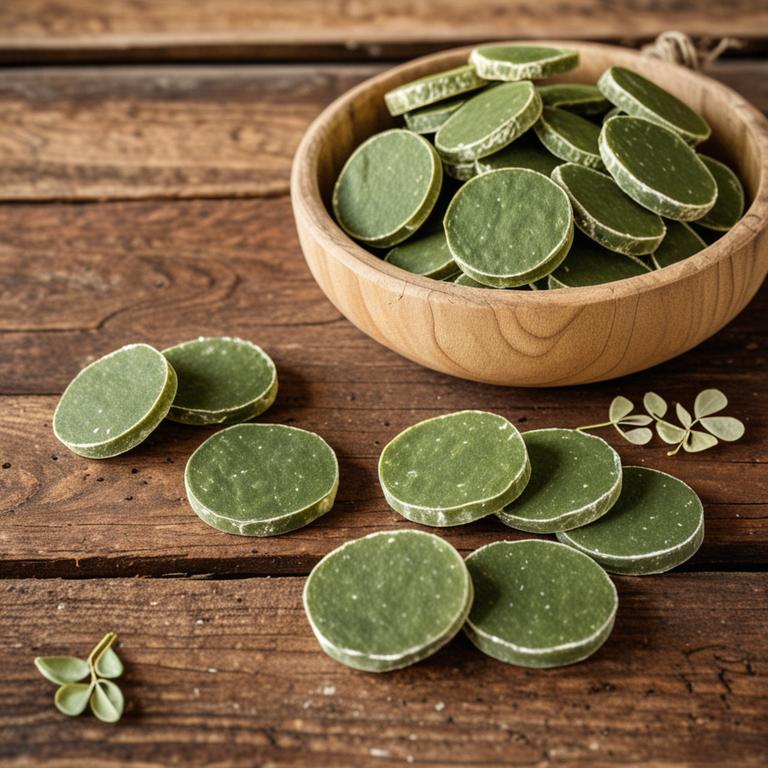
Moringa oleifera herbal lozenges are used to support respiratory health by reducing inflammation and soothing sore throats.
They contain natural anti-inflammatory and antimicrobial properties that can help alleviate symptoms of colds, coughs, and other respiratory infections. These lozenges are also beneficial for boosting the immune system due to their high concentration of vitamins and antioxidants. The gentle formulation makes them suitable for daily use, especially for individuals seeking natural remedies for throat irritation.
Overall, moringa oleifera herbal lozenges offer a safe and effective way to promote oral and respiratory wellness.